hartleyfamily.uk
- The HARTLEY Surname - Origins of the Name [an ongoing hartleyfamilyorguk
project]
1]
Who are the Hartleys ? When did they originate ?
2]
Where did the surname 'HARTLEY' come from ? Why the surname, HARTLEY ?
3]
Who were some of the earliest HARTLEYs and where did they come from ?
So
let's begin by finding out ... Who are the indiginous British and Irish ?
Here's
a brief history of the peoples of Britain and Ireland ... scholars, look away,
now !
"In
my search around the world I have more than once found that oral myths are closer
to the genetic conclusions than the often ambiguos scientific evidence of archaelogy"
- Professor Bryan Sykes [wiki]
from his book 'Saxons, Vikings, and Celts the Genetic Roots of Britain and Ireland'
Taking
Professor Sykes' advice, hartleyfamilyorguk has included old historical
accounts [oral myths], as well as other historical, archaeological, and genetic
information, to create a comprehensive study of where the HARTLEYs originated;
the ancient historical accounts ['myths'] are vital in understanding the HARTLEY
surname, it's roots and it's peoples, even if they haven't yet been confirmed
by archaelogical studies and genetic research.
Much evidence shows, that from time to time, relatively small new groups of
peoples arrived in Britain and Ireland, from near and far - some nomadic, some
who came and returned home and some who settled for good. For thousands of years
just after the Last Great Ice Age, Britain and Ireland continued to be populated
seasonally by hunter-gatherers, and later by agricultural settlers. They were
the ancestors of most people living in Britain and Ireland today, they were
the indiginous British and Irish. The reality is far from the old idea, that
invading armies of Romans, Anglo-Saxons, Vikings and Normans replaced the original
'British and Irish' settlers. 'Invaders' probably only added 5%-10% of new DNA
to the modern British genetic pool, even less in Ireland. Where they had technologies
and resources that allowed them to become militarily or economically dominant
[like the Romans, Danish Vikings and Normans], new settlers took over positions
of power [within royalty and the aristocracy], or chose native leaders who could
do the job for them. They added to the British and Irish language, the technology
and the culture. However, it does appear that the original British and Irish
language and culture survived, including material artifacts, social organisation
and mythology, some even survived through to the present day. Evidence also
shows that exchange of technology and culture took place through trade. And
the indiginous British and Irish also travelled to near and far, some even settled
abroad, taking with them British and Irish language and culture. Some returned,
bringing back new ideas, new designs, which were adopted throughout Britain
and Ireland.
Conclusion:
Britain and Ireland experienced continuity, not invasion, widespread
destruction and total change.
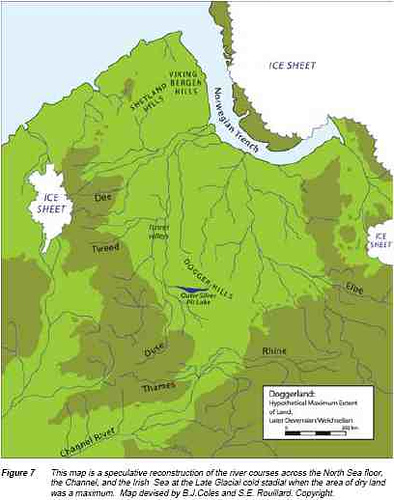 Before the Last Great Ice Age: archaeology and DNA analysis have shown
that native Europeans had lived in [what is now] Britain and Ireland for well
over 750,000 years, probably as far back as 1.2 million years ago. Over time,
on several occasions, major shifts in climate had covered the area with ice
sheets over a kilometer thick. These glaciers scraped the land bare and removed
much of what went before. During this time, Homo antecessor, Heidelberg Man,
Neanderthals and Cro-Magnons had populated the land. In relatively recent times,
they had all merged or died out, leaving just one, modern Homo Sapiens, in Europe.
Before the Last Great Ice Age: archaeology and DNA analysis have shown
that native Europeans had lived in [what is now] Britain and Ireland for well
over 750,000 years, probably as far back as 1.2 million years ago. Over time,
on several occasions, major shifts in climate had covered the area with ice
sheets over a kilometer thick. These glaciers scraped the land bare and removed
much of what went before. During this time, Homo antecessor, Heidelberg Man,
Neanderthals and Cro-Magnons had populated the land. In relatively recent times,
they had all merged or died out, leaving just one, modern Homo Sapiens, in Europe.
As the Last Great Ice Age descended some 50,000 years ago, it is thought by
some that native Europeans retreated to warmer climes in Southern Europe and
Central Asia, as highlands in Northeren Britain and Ireland and Scandinavia
became covered once more in very thick ice and tundra. However, it is clear
many of our hunter- gatherer ancestors continued living just south of the maximum
extent of the ice covered mountains, in an area we now call 'Doggerland'. The
highland landscape was pretty much like the Arctic is today, maybe even less
hospitable, making it very difficult for humans and wildlife to survive ...
but they did.
18,000 years ago, the sea level was still more than 120m lower than today;
there were no islands as we know them today; Britain was joined to Ireland,
it was joined to Scandinavia, and it was joined to to the continent of Europe
[shown on the map above]. As long ago as 1490, geographers knew the British
Isles had been joined to Europe before 'the Flood'; Dominicus Marius Niger:
Domenico Mario Negri [fl.c.1490], geographer: "... that in the beginning, when
God framed the world, and divided the waters apart from the earth, this [British]
Isle was then a parcel of the continent, and joined without any separation of
sea to the mainland."
The
earth's population, then, totalled no more than about one million people.
The population of what is now Southern Britain and Ireland was very small, possibly
just a few hundred hunter-gatherers [likely
native Europeans, haplogroups G and I [M170]]
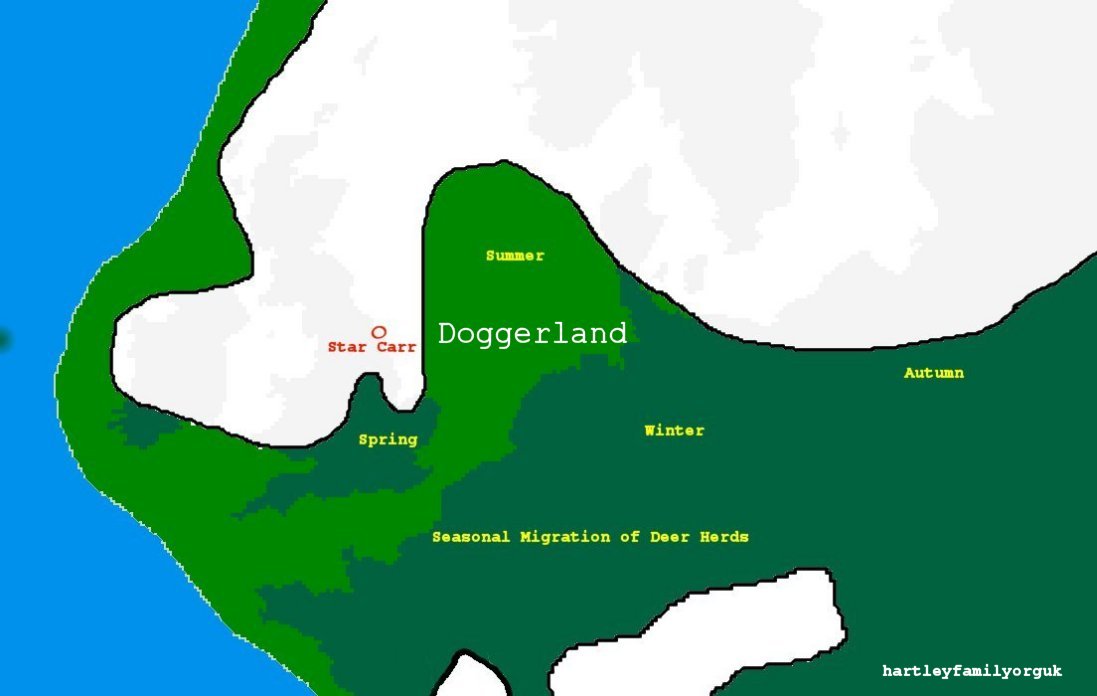 between 14 000 years ago and 9 000 years ago: as the Last Great Ice Age
was coming to an end, melting ice raised sea levels. Britain separated from
Ireland, but was still connected to mainland Europe. Growing numbers of native
European nomadic hunter-gatherers [including native Europeans pre-haplogroup
I1] travelled seasonally, by land and by sea, following migrating fish and herds
of animals, including deer. They built substantial 'seasonal camps' in Britain
and Ireland and were the first settlers;
between 14 000 years ago and 9 000 years ago: as the Last Great Ice Age
was coming to an end, melting ice raised sea levels. Britain separated from
Ireland, but was still connected to mainland Europe. Growing numbers of native
European nomadic hunter-gatherers [including native Europeans pre-haplogroup
I1] travelled seasonally, by land and by sea, following migrating fish and herds
of animals, including deer. They built substantial 'seasonal camps' in Britain
and Ireland and were the first settlers;
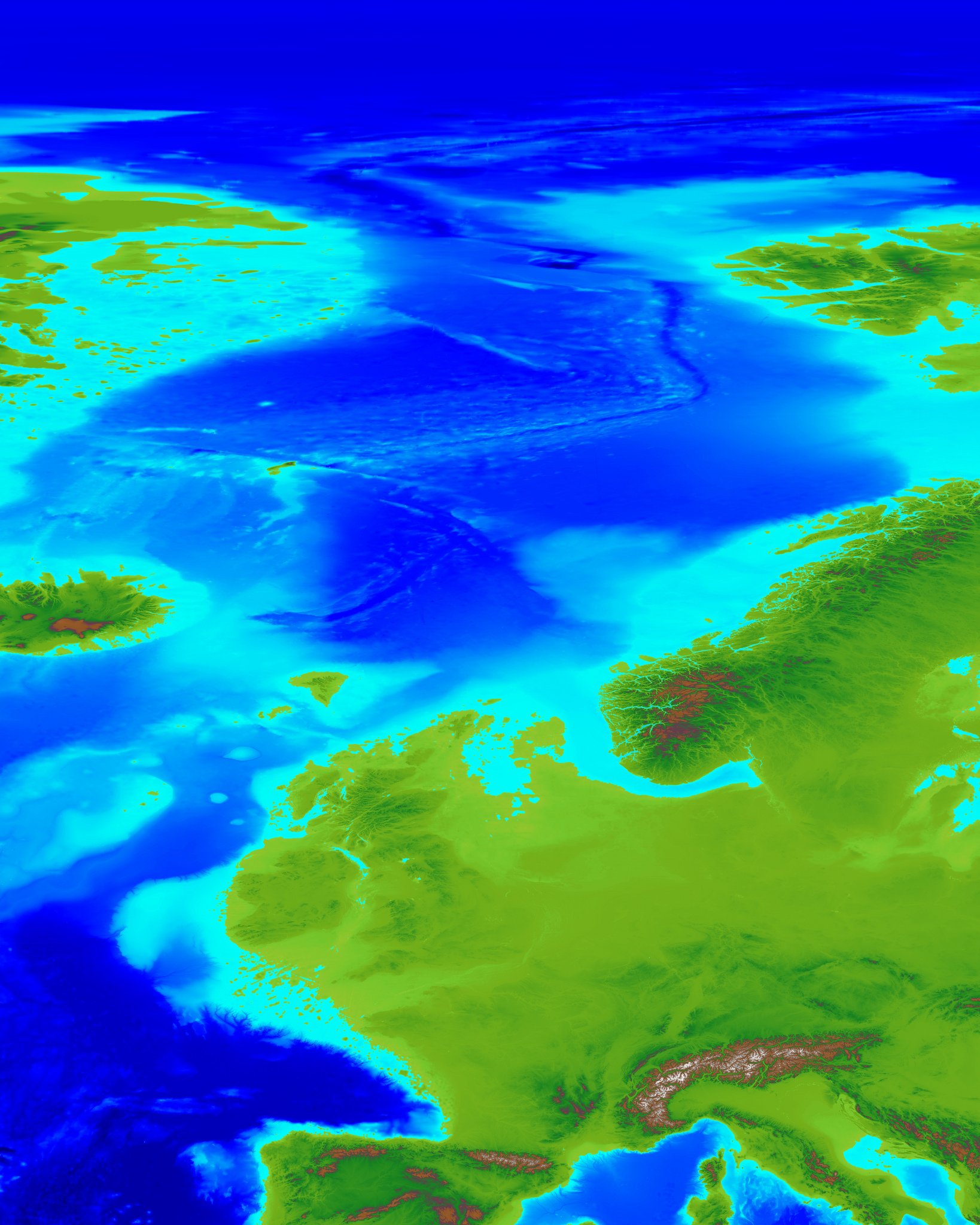 aerial map of N.Europe and the N.Atlantic, showing Doggerland surrounding the
British Isles.
aerial map of N.Europe and the N.Atlantic, showing Doggerland surrounding the
British Isles.
c.10,500BP
Star Carr records the first
round houses. Diet included hunted Deer, Elk, Aurochs, Wild Boar, Beaver, Hare
and Badgers. People constructed small boats so that they could travel up rivers
and explore the environment and transport people and small quantities of goods.
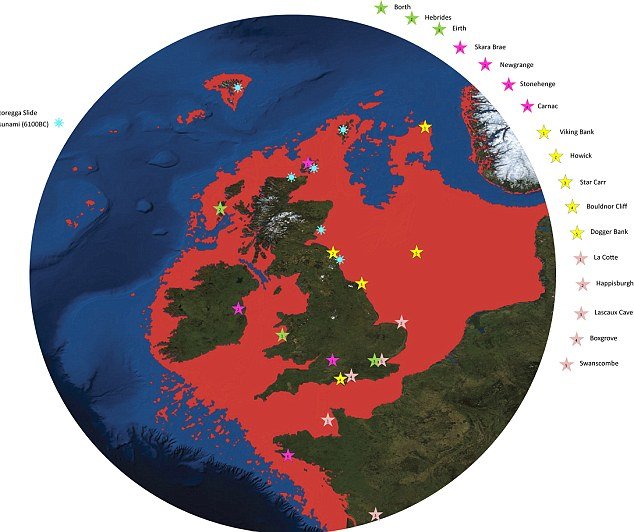
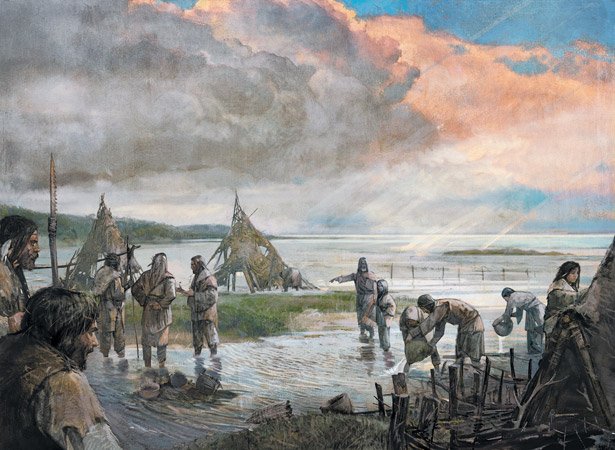
c.10,500-8,000BP Doggerland
[now the North Sea][see Storegga
Slides - Tsunamis] The Storegga Slides were a series of underwater landslides,
in which a piece of the Norwegian continental shelf slid into the Norwegian
Sea. The immense landslips occurred between 10,150BP and 8000BP, and caused
three tsunamis, each up to 20 metres [66 feet] high, that swept across Doggerland.
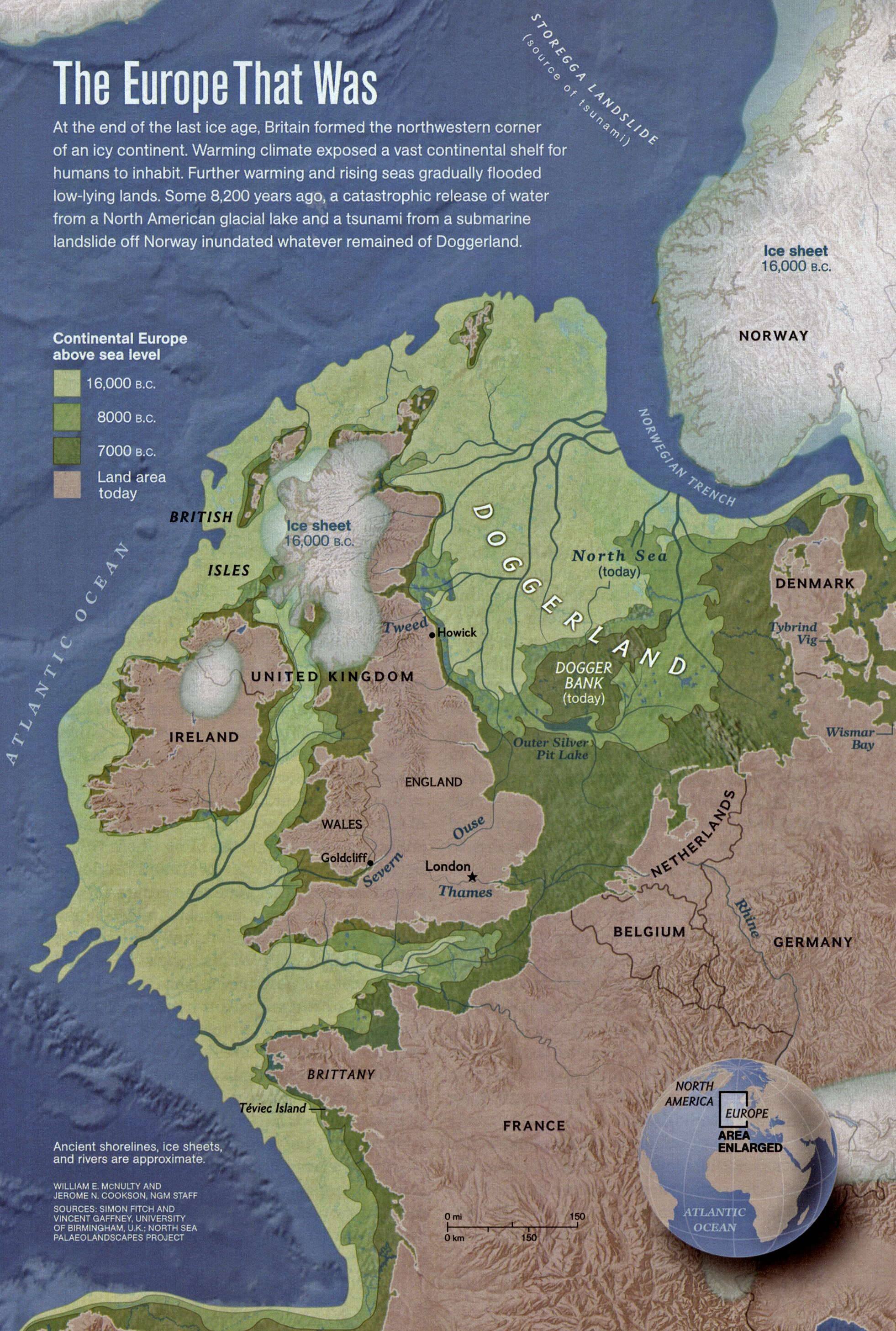 c.7,000BP: the hunter-gatherers were joined by [mostly male] agricultural
settlers from South West Europe and from East Europe and Central Asia including
Samotheans [see later, below]. The vast majority were non-native European male
settlers who brought R1b and R1a male Y-DNA with them and that is the DNA that
is still dominant in Britain and Ireland today; descendents of those early settlers
are also indiginous British and Irish; most present day British and Irish are
descended from them. Some settlers chose native female hunter-gatherers for
mates; together they populated the area. These Europeans and Asians are the
forefathers of the majority of the British and Irish, as well as the Dutch,
Germans and French; hence, most British, Irish, Dutch, Germans and French, today,
are blood-related through common ancestors.
c.7,000BP: the hunter-gatherers were joined by [mostly male] agricultural
settlers from South West Europe and from East Europe and Central Asia including
Samotheans [see later, below]. The vast majority were non-native European male
settlers who brought R1b and R1a male Y-DNA with them and that is the DNA that
is still dominant in Britain and Ireland today; descendents of those early settlers
are also indiginous British and Irish; most present day British and Irish are
descended from them. Some settlers chose native female hunter-gatherers for
mates; together they populated the area. These Europeans and Asians are the
forefathers of the majority of the British and Irish, as well as the Dutch,
Germans and French; hence, most British, Irish, Dutch, Germans and French, today,
are blood-related through common ancestors.
It is estimated that only a thousand or so people populated the whole of Britain
and Ireland at that time.
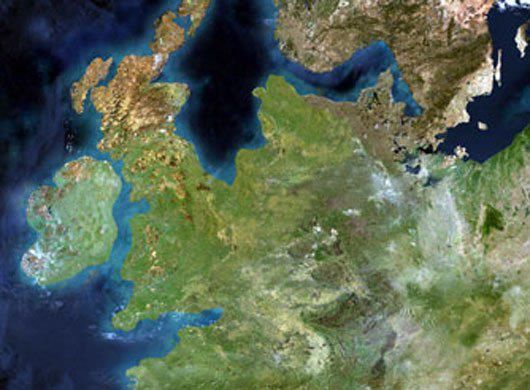 About 6 000 - 7 000 years ago: a large river basin stood between Europe
and the 'British Peninsular', connecting major rivers that ran across Britain
and Europe. About 6000 years ago, as melting ice continued to raise sea levels,
the river basin gradually flooded; sea engulfed the lands once occupied by humans
and wildlife [Doggerland, shown on the map] and formed what is now the North
Sea and English Channel. Henceforth, Britain was cut off by land from continental
Europe and the seasonal migration pattern was broken. Britain became a group
of islands. Some hunter-gatherers and wildlife was stranded in Britain, unable
to get back to the mainland. Other groups would have adapted, travelling to
and fro by boat. Over time, successive waves of new agricultural settlers came
to Britain and Ireland from Europe and Asia, bringing with them different cultures
and technologies, some of which were adopted. Settlers came from near and far,
from the whole of Europe, Turkey and the Middle East, Central Asia, even parts
of North and East Africa. Most of the male DNA brought by new settlers were
of the same haplogroups as that already held by the British and Irish; mostly
R1b, but also R1a and I [M170].
About 6 000 - 7 000 years ago: a large river basin stood between Europe
and the 'British Peninsular', connecting major rivers that ran across Britain
and Europe. About 6000 years ago, as melting ice continued to raise sea levels,
the river basin gradually flooded; sea engulfed the lands once occupied by humans
and wildlife [Doggerland, shown on the map] and formed what is now the North
Sea and English Channel. Henceforth, Britain was cut off by land from continental
Europe and the seasonal migration pattern was broken. Britain became a group
of islands. Some hunter-gatherers and wildlife was stranded in Britain, unable
to get back to the mainland. Other groups would have adapted, travelling to
and fro by boat. Over time, successive waves of new agricultural settlers came
to Britain and Ireland from Europe and Asia, bringing with them different cultures
and technologies, some of which were adopted. Settlers came from near and far,
from the whole of Europe, Turkey and the Middle East, Central Asia, even parts
of North and East Africa. Most of the male DNA brought by new settlers were
of the same haplogroups as that already held by the British and Irish; mostly
R1b, but also R1a and I [M170].
c.6,000BP:
One reference to the ancient history of the British Isles:
'Holinshed's Chronicle: published 1578' tells us: the earliest inhabitants of
the island which is now called Britain were the Samotheans, ruled over
by peoples from the Middle East. Their first king was called Samothes, and he
is believed to have been Meshech, the sixth son of Japheth, a son of the Biblical
Noah. Samothes was very educated in astronomy, moral values and politics. He
founded a sect of philosophers called the Samothei. He wrote Phoenician letters,
from which the Greek alphabet was derived. The Samothean kings ruled over more
than just the island of Samothea. Their kingdom included a large part of Europe
from the Rhine to the Pyrennes, an area known as Gallia [the Gauls]. Samothes
is said to be the founder of Celtica; the Celts and Gauls, the same race. The
Samotheans introduced a mother language to Europe, Proto-Indo-European.
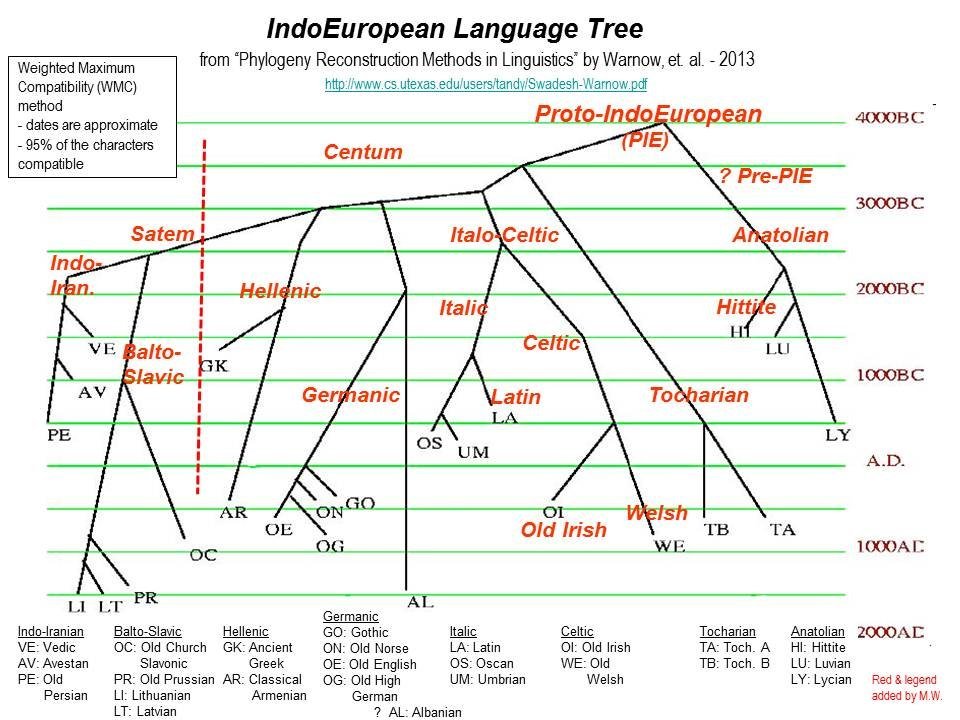
c.5,200BP:
The succession of kings after Samothes were: Magus Sarronius Druiyus [the Druids]
Bardus Longho Bardus Junior Lucus Celtes [the Celts]. Magus [the Magi] was very
educated, as was his father Samothes. Sarronius [Sarron] founded schools and
colleges to encourage people to study and be civilised. He was the founder of
a group of philosophers called the Sarronides, who offered sacrifices, believing
that they should only be made by people who were skilled in divine mysteries.
Druiyus [Druis] was the founder of the Druids. Initially a true religion taught
by his predecessors, after Druiyus' death, the Druids became pagan. Bardus was
a poet and musician [hence the word 'bard']. He established an order of poets
or heralds called 'Bardi', and it was said "they were held in such high
esteem that if two armies were engaged in battle, and the Bardi walked among
them, the battle would stop until they had gone".
c.4,500-3,500BP:
Albion invaded Samothea [In 930, the English King Ćthelstan used the title:
rex et primicerius totius Albionis regni "King and chief of the whole realm
of Albion". Albion was still remembered over 3,000 years later].
Hercules [the Greek] defeated Albion and Bergion, the Celtes continued to rule.
Hercules came to Albania [England], arriving at a headland which Ptolomie calls
'Promontorium Herculis' [Hartland Point, North Devon].
[The Egyptians and Babylonians deified their kings, a practice passed on to
the Greeks and Romans and to all the pagan world, including the Norse Gods].
Two sons of Mizraim Osiris were: Neptune Marioticus and Hercules Lybicus. [Neptune,
the son of Osiris, sailed the seas with his thirty three sons, leaving each
of them in a different place to overthrow the kingdoms that already existed
and bring the world under their own tyrannical rule]. Two sons of Neptune Marioticus
that came to the British Isles were: Albion, who invaded the island of Samothea
with an army descended from Cush. And Bergion, who invaded the island to the
west of Samothea [Hibernia, now called Ireland].
Further
kings who ruled over parts of the British Isles include: Galates Harbon Lugdus
Beligius Iasius Allobrox Romus Paris Lemanus Olbius Galates II Nannes Remis
Francus Pictus [the Picts].
Finally, Brutus invaded and set up a new succession of kings [see below: Brutus,
the Trojan-Greek son of Silvius].
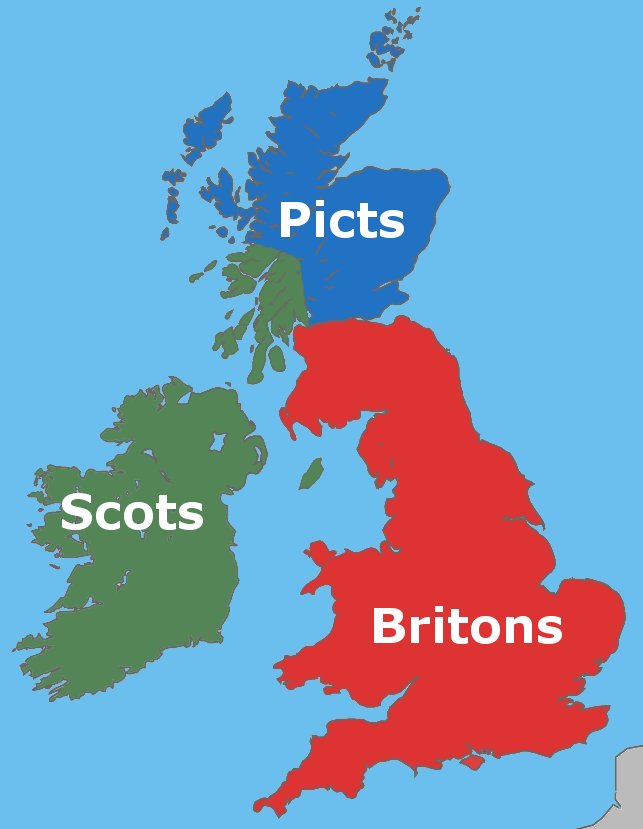 The Britons: from 4,000 - 3,000 years ago, Britannia [Britain] was being
increasingly populated by 'the Britannic' [Britons]. Britannia is said to be
named after Brutus of Troy, the Trojan-Greek son of Silvius. Silvius was descended
from Ascanius, founder of Alba Longa; his father, Aeneas, hero of Troy, and
was a descendant of Japheth the 'fair skinned one', the son of the Biblical
Noah. The Trojans land on a deserted island and discover an abandoned temple
to Diana [see Hertha, the Earth Mother Goddess, later]. After performing
the appropriate ritual, Brutus falls asleep in front of the goddess's statue
and is given a vision of the land where he is destined to settle, an island
in the western ocean [Britannia] inhabited only by a few giants [powerful].
The Britons: from 4,000 - 3,000 years ago, Britannia [Britain] was being
increasingly populated by 'the Britannic' [Britons]. Britannia is said to be
named after Brutus of Troy, the Trojan-Greek son of Silvius. Silvius was descended
from Ascanius, founder of Alba Longa; his father, Aeneas, hero of Troy, and
was a descendant of Japheth the 'fair skinned one', the son of the Biblical
Noah. The Trojans land on a deserted island and discover an abandoned temple
to Diana [see Hertha, the Earth Mother Goddess, later]. After performing
the appropriate ritual, Brutus falls asleep in front of the goddess's statue
and is given a vision of the land where he is destined to settle, an island
in the western ocean [Britannia] inhabited only by a few giants [powerful].
The Britannic were Brython-Celtic and North Germanic speaking [wiki].
By their language and DNA they are thought to have mostly come from Western
Europe; they were Gauls [Brittany in France]; Germanic-Celts [Belgae] from France
and Belgium, from Germany, Austria and the Alps; Danaan's [Danes] from Denmark
and North Germany; and the Brigantes from Spain and Portugal [Atlantic People,
sometimes referred to as Celts]. They probably account for 50%-80% of male R1b
Y-DNA found in Britain today. Almost all HARTLEYs [tested so far] have haplogroup
R1b Y-DNA so are more than likely descended from the Britannic.
The story goes on; Brutus had three sons and three areas of Britannia were named
after them; Albania aka Albany [the Far North of Britannia, Brigantia [see below]
and Pictland populated by the Picts] named after Albanactus; England named after
Locrinus [Laegria: East Anglia, named after Laegrus]; Cambia [Wales] named after
Kamber [Cambus]. It is recounted that Albanactus was killed shortly after he
began his reign, by Humber, King of the Huns. Humber invaded Albany from Germany
and met Albanactus's army in battle, where Humber killed Albanactus. This forced
the people of Albany to flee south to Albanactus's brother, Locrinus.
The population of Britannia had by now grown to about 100,000, most of whom
were the descendents of the indiginous British and Irish settlers, their language
a mix of North Germanic [Scandinavian, later Middle English], Brython-Celtic,
Welsh and Irish.
Pytheas
of Massilia [4thC BC] was a Greek Geographer and Explorer from the Greek colony,
Massilia [modern day Marseille]. He made a voyage of exploration to North Western
Europe c.325 BC. He circumnavigated and visited a considerable part of Britannia.
An earlier unknown 6thC BC Greek explorer makes brief mention of a visit to
"the sacred isle" Ierne [Ireland] located across from Albion [the early name
for Britain]. Pytheas [and also Diodorus] reported that Britannia was "cold
and subject to frosts, being too much subject to the bear" [suggesting he visited
in the early Spring]. "The numerous population of natives live in thatched
cottages [Iron-age round houses], store their grain in subterranean caches and
bake bread from it. They are of simple manners and are content with plain fare.
They are ruled by many Kings and Princes who live in peace with each other.
Their troops fight from chariots, as did the Greeks in the Trojan War."
Three 'corners' of Britannia are mentioned; Kent, the Orkneys and Cornwall ...
"The inhabitants of Cornwall are involved in the manufacture of tin ingots.
They mine the ore, smelt it and then work it into pieces the shape of knuckle-bones,
after which it is transported to the island of Ictis [probably St Michael's
Mount]; during the ebb of the tide the intervening space is left dry [a causeway]
and they carry over to the island the tin in abundance in their wagons. Here,
the merchants buy the tin from the natives and carry it over to Gaul, and after
travelling overland for about thirty days, they finally bring their loads on
horses to the mouth of the Rhone for transportation down to the Mediterranean.
The inhabitants of Cornwall are civilised in manner and especially hospitable
to strangers because of their dealings with foreign merchants."
The
Picts: between 3,000 - 2,500 years ago, it is said a massive fleet of long-ships
headed by King Rodric and the Picts [painted 'tatooed' people] landed north
of the Rivers Clyde and Forth, in Albania [what we now call Scotland]. The kingdom
was named Pictavia or Pictland [marked in blue on the map above]. The Picts
were from Scythia [an area spanning from north of the Black Sea to the Baltic,
the Ukraine, across Russia, almost to China], shown on the male 'Haplogroup
R1a' map above.
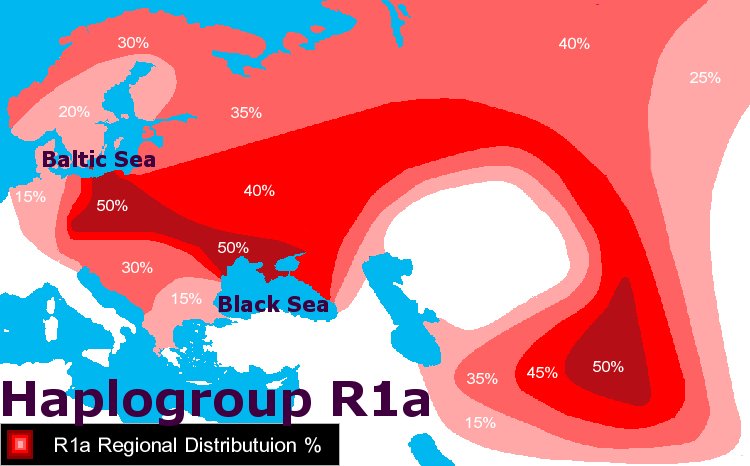 It is thought Scythians
account for much of the male R1a Y-DNA found today in the British Isles. Scythians
were descended from Magog, the brother of Javan, so both the Scythians and Britons
were descended from Japheth and Noah. It is interesting to note that a 12thC
leader of the Western Hebredes Isles and Isle of Man, Somerled [thought by some
to be a Norse Viking] had R1a DNA. He married the daughter of King Olaf, thought
to be descended from the Kings of Norway. It has been suggested by Professor
Bryan Sykes that some half a million Scots today may be descended from Somerled,
hence they may be descendants of Norsemen. However it is thought Somerled was
not a Norseman but a Scythian-Pict.
It is thought Scythians
account for much of the male R1a Y-DNA found today in the British Isles. Scythians
were descended from Magog, the brother of Javan, so both the Scythians and Britons
were descended from Japheth and Noah. It is interesting to note that a 12thC
leader of the Western Hebredes Isles and Isle of Man, Somerled [thought by some
to be a Norse Viking] had R1a DNA. He married the daughter of King Olaf, thought
to be descended from the Kings of Norway. It has been suggested by Professor
Bryan Sykes that some half a million Scots today may be descended from Somerled,
hence they may be descendants of Norsemen. However it is thought Somerled was
not a Norseman but a Scythian-Pict.
Centuries later, the Roman leader of the Britons, Marius, defeated the Picts
and took lands south of Hadrian's Wall named Westmorland, now called Cumbria.
Marius must have come to an agreement with the Picts as he allowed them to take
300 noble women from the Scots as wives to increase their numbers, something
that must have very much annoyed the Scots, as it was likely the intention,
to split the Picts and the Scots. Together, the Scots and Picts had formed an
alliance and often fought the Britons for land and power so the Romans were
out to break that alliance.
The
Scots: about 2,350 years ago, the Scots [Sciti] came to Hibernia
[Ireland]. The Scots were named after Scotta, an Egyptian Pharoah Nectonebus'
daughter who was 'Queen of the Scots'. She was married to Milidh [the Milesian]
of Spain, a Scythian-Goth descendant, the grandson of Breogán, King of Brigantium
[Corunna] in Spain [see below]. Again, Milesians are thought to be descendants
of Magog, the son of Jepheth, son of Noah. Queen Scotta and Milidh sailed from
Spain and defeated the Tuatha Dé Danann [Peoples of Danaan [Danes from Denmark]
in Ireland, henceforth the people of Ireland were called 'Scots' [marked green
on the map above, also known as Scocia and the people as Gaels]. Scots also
inhabited parts of North Wales.
Eventually the Scots took revenge for the taking of their womenfolk by Picts;
they invaded and settled in the West of Pictland, around Dumbarton, then moved
inland and overthrew the Picts completely, taking their kingdom; Pictland was
then renamed 'Scotland'.
The Scots, but more likely the Tuatha Dé Danann [peoples of Denmark, ie Danes],
and the Picts, were noted for their fair hair and bright eyes; we can thereby
assume, since the Danes and Picts were descended from Noah and his sons Japeth
and Magog, they, too, had fair hair and bright [ie not dark brown] eyes. The
Tuatha Dé Danann originated in Achaia on the Greek mainland. Before them, many
other tribes had settled in Ireland; the Cessair, [2960-2360BC], descendants
of Bith, Noah's son; the Partholón [2500-2000BC],descendants of Magog, from
Migdonia, Thracia, an area south of the River Danube, between the Black Sea
and the Aegean Sea, North of Greece; the Nemed [2350-1730BC] from the Caspian
Sea, and the Fir Bolg, also from Thracia.
Danaans [Danes] took their name from the Goddess Dana/Donau/Danu, after whom
the River Danube is named. Danu is a Scythian word for 'River', hence the River
Danube [and River Don etc]; she's also the Hindu Goddess Danu, the Goddess of
Water. Danaan's probably account for some of the I1 Y-DNA in Britain today,
though most I1 DNA probably came from native European Norsemen [from modern-day
southern Norway, Sweden and Finland], Angles from the Western Baltic, and Normans
who themselves could trace their roots back to Norsemen [see Haplogroup I chart
below].
The Danaan's King was Dagda, the father of the Goddess 'Brigit' who is also
called the Goddess 'Brigantia' of the Brigantes [see below]. The Goddess
Danu is the same Roman Goddess 'Diana' [Diana is likely named after Danu], the
Goddess Nerthus, she's also the Greek Goddess 'Artemis', the Germanic Goddess
'Hertha'; they are all the Earth Goddess, Goddess of Hunting, always depicted
with a HART [a Stag] [see HARTLEY-HERTHA connection
on the next page, Page 2]
King
Dagda is the same person as the Hindu 'Daksha', a Creator God, the son of Brahma,
and the same as the Roman God, Silvanus.
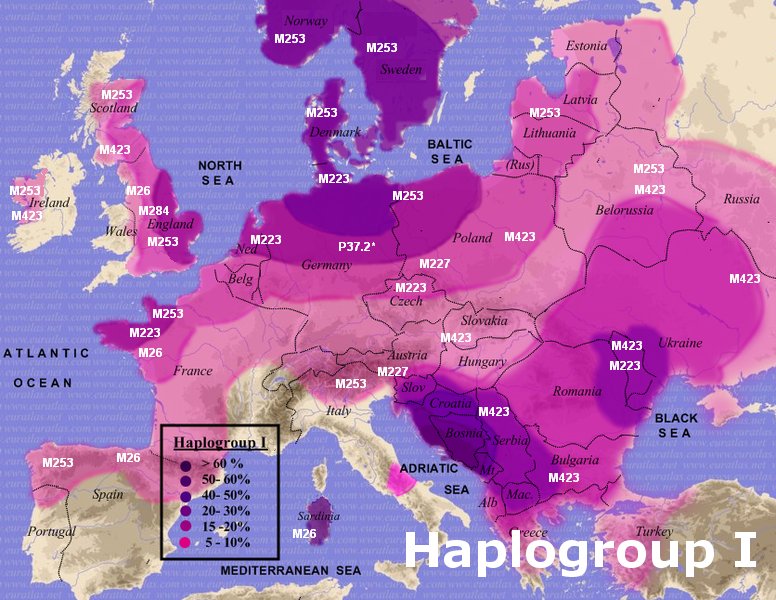 Goths and Dacians arrived from the West of Scythia, from the Carpathian mountains,
west of the Black Sea, the lower Danube, the Balkans and the island of Sardinia,
some of whom brought male I1[b] Y-DNA [shown in dark blue on the 'Haplogroup
I' map above]
Goths and Dacians arrived from the West of Scythia, from the Carpathian mountains,
west of the Black Sea, the lower Danube, the Balkans and the island of Sardinia,
some of whom brought male I1[b] Y-DNA [shown in dark blue on the 'Haplogroup
I' map above]
Areas of Northern and Eastern England and Scotland and parts of Wales and Ireland
were gradually populated by more and more Norse and Germanic peoples [early
Vikings, Danes, Fresians and Saxons] from present-day Scandinavia, Holland and
North Germany. They brought more native European male I1 Y-DNA, again noted
for fair hair and bright eyes [also shown in dark blue on the 'Haplogroup I'
map above]. The Norse and Germanic peoples were to come in much greater numbers
many centuries later [see below].
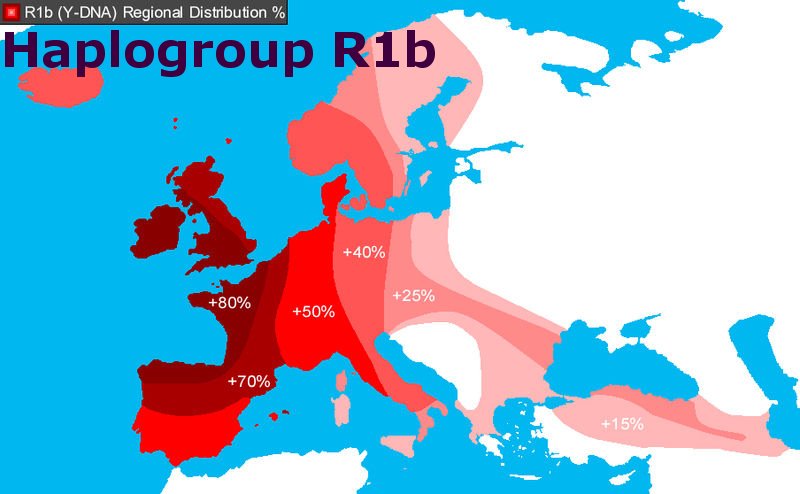 Atlantic peoples came
in large numbers from present-day France, Spain, Portugal and Italy populated
the South and West of England, Wales and Ireland. They, like the Britons, account
for male R1b Y-DNA commonly found in Britain and Ireland, Germany and France
[shown in dark red on the 'Haplogroup R1b' map above]. Atlantic people included
peoples from Africa and the Middle East, which could account for male E1b1b
Y-DNA found significantly in Ireland. Or some of the E1b1b Y-DNA could have
come from Egyptian males who travelled with Queen Scotta.
Atlantic peoples came
in large numbers from present-day France, Spain, Portugal and Italy populated
the South and West of England, Wales and Ireland. They, like the Britons, account
for male R1b Y-DNA commonly found in Britain and Ireland, Germany and France
[shown in dark red on the 'Haplogroup R1b' map above]. Atlantic people included
peoples from Africa and the Middle East, which could account for male E1b1b
Y-DNA found significantly in Ireland. Or some of the E1b1b Y-DNA could have
come from Egyptian males who travelled with Queen Scotta.
The
population of Britain was probably 250,000 or so by 2,000BC
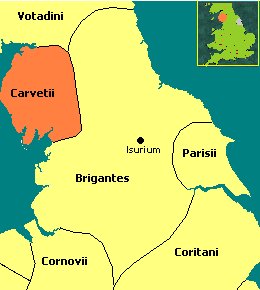 Homeland of the Northern HARTLEYs today is Lancashire and Yorkshire,
historically part of
Northern Britain controlled by the Brigantes:
Homeland of the Northern HARTLEYs today is Lancashire and Yorkshire,
historically part of
Northern Britain controlled by the Brigantes:
Brigantes:
The tribe who controlled the largest kingdom known as Brigantia
was the Brigantes. It is not certain when they arrived, but it was likely 4,000
- 3,000 years ago. They took their name from Breogán, King of Brigantium [Corunna]
in Spain so were Atlantic People from Spain and Portugal, hence like the Milesians
in Ireland, they are thought to be Scythian-Goths, descendants of Magog, the
son of Jepheth, son of Noah.. The Brigantes kingdom covered what is now Yorkshire,
Lancashire, Cumbria, Durham, Northumberland, South East Scotland, the North
Midlands and parts of the south of Ireland around Wexford, Kilkenny and Waterford.
Those areas happen to be where northern HARTLEYs most commonly originate. Brigantes
meant 'the high, elevated ones, the highlanders', which could have been derived,
as Greek Milesians, from their higher social status, above other tribes; or
it could have been derived from the hilly Pennines and Lake District where they
settled; and/or it could have been derived from their construction of hill top
forts [see below]. During Roman times the Brigantes was the most militant tribe
in Britannia, made up of very well trained, fierce warriors.
The
Brigantes were subdivided into:
Gabrantovices of coastal North Yorkshire, the Goat fighters
Latenses of the Adel, Leeds area [Burgodunum]
Setantii in coastal Lancashire around Flyde-Fleetwood [Portus
Setantiorum Port of the Setantii]
Corionototae from the south side of Hadrian's Wall around Corbridge [Coria]
Lopocares from the south side of Hadrian's Wall around Durham [Vinovium],
Northumberland, Newcastle Upon Tyne, Gateshead, North and South Tyneside and
Sunderland.
Textoverdi from the south side of Hadrian's Wall in the upper valley of
the River Tyne [Vindolanda
Chesterholm]
also, the independant tribe of
Carvetii of North Cumbria, from the Carlisle/Eden Valley area [Luguvalium
Carvetiorum] [Carvetii].
The Deer/Stag People, their principal deity seems to have been the God
of War, Belatucadrus [the Roman God, Mars; the Greek God, Ares], although the
Roman name for Carlisle, Luguvalium Carvetiorum, seems to come from 'Lugus'
who was the Roman God 'Mercury', the Messenger, God of Trade, Profit and Commerce;
the Greek God 'Hermes', the Patron of Boundaries and of the Travelers who cross
them, of Shepherds and Cowherds, of Thieves and Road Travelers, of Orators and
Wit, of Literature and Poets, of Athletics, of Weights and Measures, of Invention,
of General Commerce, and of the Cunning of Thieves and Liars.
NB: Perhaps Carvetii should have the prefix 'Cerv' meaning 'deer', making it
Cervetii ?
From historical records it is uncertain where the Carvetii Tribe originated
before the Bronze and Iron Ages, though this may be determined at some point
by DNA testing. If they were deer herdsmen, they may have been Norsemen who
originated in Scandinavia. They may also have been painted 'tatooed' people,
perhaps fair haired 'Albani', closely associated with the Picts, so may have
come from Scythia. The consort of Queen Cartimandua of the Brigantes, Ventutius,
is thought to have been Carvetian [see below].
Parisii
tribe: the Parisii were bordered by the Brigantes in the rest of the Yorkshire
area, just north of the River Humber. [see map above] a culturally distinct
group of people who inhabited the area at the time. Parallels exist with continental
burial rites in Gaul [Paris, France]. The Arras culture indicates strong cultural
and economic links between the two regions during the period.
ERTHA,
the Germanic Earth Goddess Tacitus wrote: "Nothing remarkable occurs
in any of these tribes [of Northern Germany], except that they unite in the
worship of Ertha [HERTHA], or Mother Earth. They believe that she interposes
in the affairs of men, and visits the different nations in her chariot*.
On an island of the ocean stands a sacred and unviolated grove, in which is
a consecrated chariot, covered with a veil, which the priest alone is permitted
to touch. He becomes conscious of the entrance of the goddess into this secret
recess; and with profound veneration attends the vehicle, which is drawn by
yoked cows. At this season all is joy; and every place which the goddess deigns
to visit is a scene of festivity. No wars are undertaken; arms are untouched;
and every hostile weapon is shut up. At this time, only peace abroad and at
home are known. At length the same priest conducts the goddess, now weary of
mortal intercourse, back to her temple. The chariot, with its curtain, and,
if we may believe it, the goddess herself, then undergo ablution in a secret
lake. This ritual is performed by slaves, whom the same lake instantly swallows
up. Hence arises a mysterious horror and a pious ignorance of these events,
which are beheld only by those who are about to perish
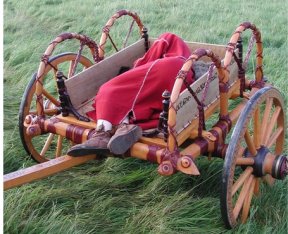 chariot* In Britain, chariot burials are characteristic of, and almost confined
to, the Iron Age Arras culture associated with the Parisii tribe. [see
below]
chariot* In Britain, chariot burials are characteristic of, and almost confined
to, the Iron Age Arras culture associated with the Parisii tribe. [see
below]
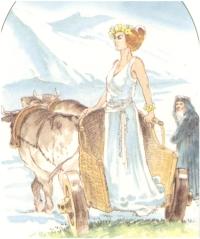 HERTHA descended from the Throne of Odin and rode there in a chariot,
a carriage covered with a mysterious veil and drawn by two cows. Wherever she
condescends to come and accept the hospitality of humans, there are days of
rejoicing and weddings, no war is fought, no weapon reached for, every iron
object is locked away. Only peace and calm are then known and desired. This
lasts until the Goddess has sojourned long enough among humans and the priest
leads her back again into her sanctuary. Only her consecrated priest was allowed
to accompany her. Slaves were also brought along to lead the draft animals and
to wash the chariot, but they were drowned in the lake immediately upon completing
their task, because any unconsecrated person who caught sight of the Goddess
would have to die. For this reason nothing more is known about the worship of
this Goddess.
HERTHA descended from the Throne of Odin and rode there in a chariot,
a carriage covered with a mysterious veil and drawn by two cows. Wherever she
condescends to come and accept the hospitality of humans, there are days of
rejoicing and weddings, no war is fought, no weapon reached for, every iron
object is locked away. Only peace and calm are then known and desired. This
lasts until the Goddess has sojourned long enough among humans and the priest
leads her back again into her sanctuary. Only her consecrated priest was allowed
to accompany her. Slaves were also brought along to lead the draft animals and
to wash the chariot, but they were drowned in the lake immediately upon completing
their task, because any unconsecrated person who caught sight of the Goddess
would have to die. For this reason nothing more is known about the worship of
this Goddess.
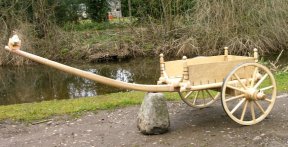 Many chariots have
been discovered, buried, across Britain and across the world dating from 2000BC
[Bronze Age]. In England, chariot burials are characteristic of, and almost
confined to, the Iron Age Arras culture associated with the Parisii tribe.
Finds of such burials are rare.The Wetwang chariot burial of ca. 300 BC is an
exception in that a woman was interred with the chariot, possibly depicting
the Earth Goddess, Hertha. Twenty one British sites are known, spanning approximately
four centuries, virtually all in the East Riding of Yorkshire. The Ferrybridge
and Newbridge chariots are unusual in Britain as they are the only ones to be
buried intact. The burial custom seems to have disappeared with the Roman occupation
of Britain..
Many chariots have
been discovered, buried, across Britain and across the world dating from 2000BC
[Bronze Age]. In England, chariot burials are characteristic of, and almost
confined to, the Iron Age Arras culture associated with the Parisii tribe.
Finds of such burials are rare.The Wetwang chariot burial of ca. 300 BC is an
exception in that a woman was interred with the chariot, possibly depicting
the Earth Goddess, Hertha. Twenty one British sites are known, spanning approximately
four centuries, virtually all in the East Riding of Yorkshire. The Ferrybridge
and Newbridge chariots are unusual in Britain as they are the only ones to be
buried intact. The burial custom seems to have disappeared with the Roman occupation
of Britain..
 The name Brigantes was linked to the Goddess Brigantia who was the Roman
Goddess Minerva, the daughter of Jupiter, the virgin goddess of warriors, poetry,
medicine, wisdom, commerce, weaving, crafts, and the inventor of music. She
is often depicted with an owl, her sacred creature and, through this connection,
a symbol of wisdom; she was also the Greek Goddess Athena, the daughter of Zeus,
the virgin goddess of wisdom, peace, warfare, strategy, handicrafts and reason,
shrewd companion of heroes and the goddess of heroic endeavour. Brigantia appears
attended by an owl, the sign of Wisdom; as the Goddess of Wisdom, Brigantia
may have links to the Greek Milesians as they were Philosophers, Writers, Architects
and Scientists.
The name Brigantes was linked to the Goddess Brigantia who was the Roman
Goddess Minerva, the daughter of Jupiter, the virgin goddess of warriors, poetry,
medicine, wisdom, commerce, weaving, crafts, and the inventor of music. She
is often depicted with an owl, her sacred creature and, through this connection,
a symbol of wisdom; she was also the Greek Goddess Athena, the daughter of Zeus,
the virgin goddess of wisdom, peace, warfare, strategy, handicrafts and reason,
shrewd companion of heroes and the goddess of heroic endeavour. Brigantia appears
attended by an owl, the sign of Wisdom; as the Goddess of Wisdom, Brigantia
may have links to the Greek Milesians as they were Philosophers, Writers, Architects
and Scientists.
Certainly the Brigantes are linked to other tribes from Central Southern Europe,
which is where they are thought to have originated before they came to Briton
after the Great Ice Age. There are several Briga- prefixed names scattered throughout
Europe, at:
Brigantium
Hispaniae also known as 'Brigantinus Portus', the ancient name of the seaport
of Corunna in north-western Spain. A major settlement of the northern Gallaeci
tribe, was situated in the conventus Lucensis, part of the province of Gallia
Tarraconensis. This seaport was the western terminus of a major trade route
in tin, gold, lead and silver. Brigantium
took it's name from Breogán, King of Brigantium [Corruna] in Spain, thought
to be a descendant Scythian-Goths and of Magog, the son of Jepheth, son of Noah.
Brigantes [as mentioned, the major tribe of Northern Briton] Tribal capital
Aldborough 'Isurium Brigantum' in North Yorkshire.
Brigantii People of Central Raetia whose tribal capital named Brigantium was
situated on the south-east shore of the 'Brigantinus Lacus', a lake in Raetia
in the Alps, now known as Lake Constance, through which the River Rhine flows.
Another of their major towns was Cambodunum.
Brigantium Raetiae Tribal capital of the Brigantii situated on the eastern shores
of Brigantinus Lacus in Central Raetia. Now known as Bregentz on Lake Constance
in the Austrian Tyrol.
Brianza is a geographical area at the foot of the Alps, in north-western Lombardy,
northern Italy. Brianza [Latin: Brigantia] derives from the Brigantes, or Brigantii,
an ancient tribe who existed there two thousand years ago.
Brigantio [Brianco, Latin Brigantium] Roman settlement in the Cottian Alps in
the Hautes-Alpes department in the Provence-Alpes-Côte d'Azur region in southeastern
France.
In
the 1st Century BC: tens of thousands of Romans 'invaded' Britain, arriving
with peoples from as far afield as Italy and the Mediterranean, Central and
Eastern Europe and Africa.They seem to have brought with them some basis of
written law and order and there continued a period of relative peace. By the
1stC, peoples of Britain and Ireland were already of very mixed 'cosmopolitan'
origins, as they still are today. Britain was called 'Britannia' by the Romans,
and it is thought it was already so named before the Romans arrived.
The Romans had launched a major military campaign to conquer the areas that
pirates, Vikings, were using as bases. The Vikings were fiercer than any of
the Mediteranean pirates and their home bases were far to the north in Norway
and Denmark. No Roman army or fleet had ever attempted to operate that far north.
The Romans did not like the north European winters and generally did not try
to occupy lands too far north. We'll never know how the Romans would have dealt
with Vikings in their Scandinavian homelands, but it's an interesting issue
to speculate about.
 During early Roman times, the ruling Queen of the Brigantes was Cartimandua
[c.43-70AD] [the style of dress depicted in the picture is taken
from the film 'King Arthur [2004]'], who was married to her consort,
Venutius* [who was an anti-Roman warlord, see above]. Cartimandua was a 'living
deity', the Goddess Brigantia, the High Goddess.
During early Roman times, the ruling Queen of the Brigantes was Cartimandua
[c.43-70AD] [the style of dress depicted in the picture is taken
from the film 'King Arthur [2004]'], who was married to her consort,
Venutius* [who was an anti-Roman warlord, see above]. Cartimandua was a 'living
deity', the Goddess Brigantia, the High Goddess.
After Ventutius sided with the Carvetii
tribe [of which he is thought to have been a member] and with northern Caledonian
tribes, against the Romans, Cartimandua divorced him in favour of her lover,
her shield bearer, Vellocatus [who was pro-Roman] [c.69AD]. Cartimandua supported
the Romans in Brigantia but was eventually overthrown by Venutius, who had gathered
great support from the people, partly due to Cartimandua's infidelity. This
led to warfare between the Romans and Brigantes over many decades and is thought
to have been the main reason why Hadrian's Wall and the Antonine Wall were built,
namely, to prevent the Brigantes from uniting with Picts, Scots and Norsemen
to create a civil war against the Romans. Eventually the Brigantes were conquered
and Brigantia came under Roman rule [named 'Britannia Secunda'].
The
Brigantes had constructed many Bronze and Iron Age fortified towns and
hill top forts* which the Romans used as strongholds, namely at Stanwick,
Whitley [Epiacum]
and Corbridge [Coria]
in Northumberland; Carlisle [Luguvalium
Carvetiorum] in Cumbria; Binchester [Vinovium]
in Durham; York [Eboracum],
Catterick [Caturactonium],
Tadcaster [Calcaria],
Aldborough [Isurium
Brigantum] [the Brigantes capital] and Elslack [Olicana]
in North Yorkshire; Slack [Cambodunum]
in West Yorkshire; Castleshaw [Rigodunum]
Manchester, Ribchester [Bremetenacum
Veteranorum] and Lonsdale [Calatum]
in Lancashire; [Wincobank,
Carl
Wark, Templebrough
and Scholes
Coppice] Sheffield in South Yorkshire.
So
far, we have discovered that the British Isles and Ireland were re-populated
after the Great Ice Age by peoples, mostly from Europe, some from beyond; they
were the indiginous British and Irish. The majority were of R1b, the rest mostly
of R1a and I1 male DNA haplogroups.
The vast majority of people in present day Britain and Ireland are descended
from just a few thousand early settlers.
Britons were made up of many peoples; Dutch; Gauls; Germanic-Celts [Belgae]
from France, Belgium,Germany, Austria and the Alps; Brigantes [from Spain and
Portugal]; Danaan's [Danes]; Norsemen from Scandinavia; Scythians [Picts and
Scots]; Goths; Dacians; Trojan-Greeks; Romans and many more. Today, most 'British
and Irish' are descended from these original visitors and settlers, relatively
few are descended from more recent immigrants.
Carvetii and Danaan Tribes were likely closely connected with the Germanic Earth
Goddess HERTHA, the Goddess of Hunting, also known as the Roman Diana, the Greek
Artemis. Religion associated with HERTHA would have commonly been in use during
the Bronze and Iron Age across Europe and across the world.
hartleyfamilyorguk believes the name HERTHA is the origin of the family
of surnames beginning with 'HART-', a name that originated in Germanic countries.
from the Dutch: HERT; Norwegian and Swedish: HJORT; Old English: HEOROT
Late-4th
Century. Roman Britannia was one of the more thinly populated and distant
Roman provinces. Less than a million Britons were 'Romanized' over three centuries;
Britons still spoke Brython, mixed with Latin. The last Roman legion left in
the early 5th century, withdrawn back to Italy to defend Rome against a major
invasion. The authority of the Romans in Britannia had deminished. Britannia
continued to be raided by the Picts and Scots from Scotland and Ireland. However,
although some technology and farming methods changed, British and Irish culture
survived and continued.
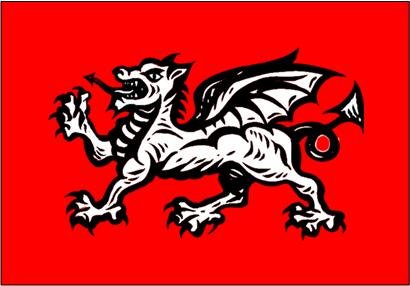 It is said the Anglo-Saxons came from Germania; they comprised: Jutes, Angles,
Frisians, Rugians [Rugii], Saxons, Huns and Boructuari [see next map below].
Having depended on professional Roman soldiers for centuries, the Britons were
unable to deal with raids carried out by the Picts and Scots. It is said the
King of the Britons, Wurtgern, called for help from the Germans and Danes, a
big mistake on the part of the Britons. Help came from North West Germany and
Denmark, areas still known today as Jutland, Friesland and Saxony; the Angles
came from 'the angle between the two', also known as Angeln, an area between
Schleswig, Kappeln and Flensburg.
It is said the Anglo-Saxons came from Germania; they comprised: Jutes, Angles,
Frisians, Rugians [Rugii], Saxons, Huns and Boructuari [see next map below].
Having depended on professional Roman soldiers for centuries, the Britons were
unable to deal with raids carried out by the Picts and Scots. It is said the
King of the Britons, Wurtgern, called for help from the Germans and Danes, a
big mistake on the part of the Britons. Help came from North West Germany and
Denmark, areas still known today as Jutland, Friesland and Saxony; the Angles
came from 'the angle between the two', also known as Angeln, an area between
Schleswig, Kappeln and Flensburg.
The story goes, the Germanic peoples and Danes led by Hengest and Horsa landed
at Ebbsfleet on the Isle of Thanet, Kent; they were so impressed by what they
found, they went back for their families and reinforcements. They came back
to 'capture' Britannia and rename the country 'Angleland' or England. The Germans
and Danes are said to have driven many Britons into Cornwall, Scotland, Wales,
Ireland, and Brittany in France. However achaeological evidence proves otherwise;
most Britons were 'absorbed', to produce 'The English', speaking a German dialect
that evolved into modern English. The Britons were not 'captured'; their language,
technologies and culture survived and continued.
click on
animated Map
of Britain 450AD to 700AD showing changes in what is referred to as 'Anglo
Saxon Britain'.
Historic
text from Adam of Bremen disputes the idea that it was Saxons who came to England;
quite the reverse in fact, Saxons [Saxones] are said to have been Angles who
came from England and settled in Hadeln near Cuxhaven, Lower Saxony, near the
mouth of the River Elbe. Certainly, people living there spoke the same language
as the Britons. South of the Saxons were the Franks [West Germanic]. To the
north of Saxony were Northmen [Norse Scandinavians]; east were Abodrites [West
Slavs]; west were Frisians, tall, big-boned and light-haired Germanic people
[Netherlands Germany and Denmark]. Saxons were made up of nobles, freemen, freedmen
and bondsmen. Their early missionary church leaders were the Angles; Winfrid
[aka Boniface] b.680 in Wessex and Willehad b.745 in Northumbria, which indicates
Saxons were in fact Angles [English].
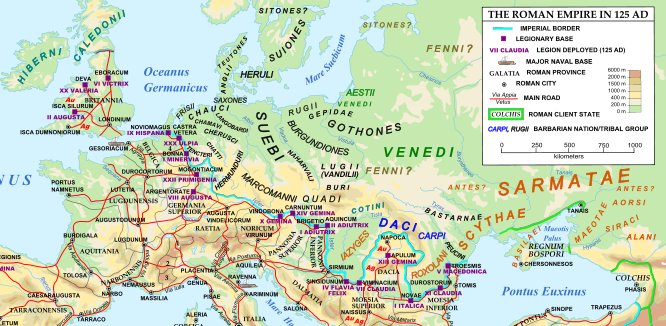
Adam of
Bremen names the Suevi [Suebi] as the original Saxon settlers. They lived in
an area between the Rhine and the Elbe, their neighbours being Druids [Gauls],
Bardi [Italians], Sicambri [Germanic Celts], Huns [Central Asians], Vandals
[East Germanic], Sarmatians [West Scythians], Lombards [Germanic Scandinavians],
Heruli [Scandinavians], Dacians [West Scythians], Marcomanni [Central Europe],
Goths [Scandinavian East Germanic], Northmen [Norse] and Slavs [East Germanic
Asians]. All these tribes later overran much of Europe and Africa.
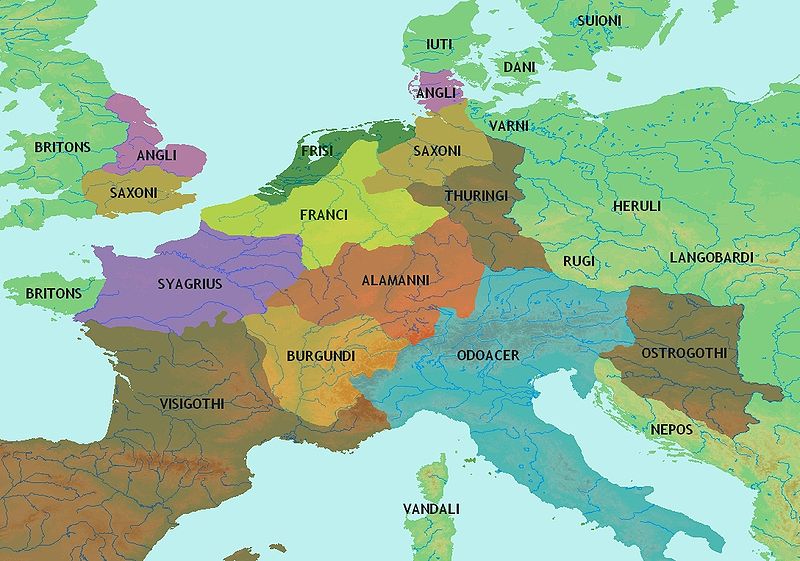 5thC European Tribes
5thC European Tribes
The
Germanic peoples and Danes were pagans; one of their Godesses was NERTHUS or
NERTHA, also known as HERTHUM or HERTHA, the Mother Earth Goddess of Hunting
[whom we shall meet later].
The Jutes, Angles, Frisians and Old Saxons seem to have established several
Kingdoms in England, based on their main tribes; the Anglii [the Angles] in
East Anglia, Middle Anglia, Mercia and Northumbria; the Reudigni [from Randsfjord];
the Aviones [islanders from Öland]; the Varini [the Wernes, the 'defenders'];
the Eudoses [Jutes, 'giants', thought to have been Goths] in Kent, the Isle
of Wight and Wessex; the Suarini [from Schwerin]; and the Nuitonesand. The 'Old
Saxons' settled in Essex, Sussex and Wessex. They were ruled by 'Danelaw'. There
was peace across the land, but disputes arose, and they found it difficult to
secure the whole of England. Viking ships occasionally came, raiding first,
trading instead if the locals were too well armed.
By
the late-7th century: Viking ships are said to have come 'in force', though
a massive invasion, accompanied by mass destruction and deaths is not found
in archaeology. It is said the Norsemen from Scandinavia 'drove' the Britons
into North East Britain, 'capturing' the East, South and Midlands by the 8th
century; it is more likely the 'driving and capturing' refers to Britons adding
some new Norse technology and culture to their own, rather than replacing or
destroying their own. Their is no evidence they were murdered en-masse or geographically
displaced. There is no DNA evidence of large numbers of males bringing native
European I1 Y-DNA. As with any new culture [even today] many Britons and Irish
didn't want the Viking culture, but most appear to have accepted it [and the
Vikings that brought it]. Vikings settled in three main areas; the Normandy
region of France, Eastern England, and Eastern Ireland. The Irish settlements
had no impact on later European history, but the English, and particularly the
French ones, did [see Normans, later].
The late-4thC to 8thC was a period when Europe was 're-organizing' after the
demise of Roman rule. While Charlemagne controlled most of France and Germany,
he did not have enough troops available to deal with the Vikings. It's doubtful
if the Romans would have been able to deal with the Vikings, either; the Romans
occasionally had serious problems with large scale piracy from Vikings [and
others] in the Mediteranean.
The
word "Viking" refers to an occupation, that is slipping up little streams and
creeks --viks-- to plunder unsuspecting villages. The people commonly called
Vikings were the Norse, a Scandinavian sea faring people from Norway, Denmark,
Sweden and Finland.
The same population pressures that caused the Viking tribes to leave Scandinavia
several centuries before the Romans, continued. In the meantime, the Scandinavians
perfected their ship building technology and produced a light, swift sailing
ship that could also use oars to good effect. This, the Viking long ship, was
originally intended for trade. The Vikings were, basically, traders. But they
were also fierce warriors and soon noted that many of the places they came upon
in Europe were wealthy, and undefended. What eventually stopped the Viking raids,
later in the early 10th century, was the unification of Norway, and the earlier
establishment of Viking settlements in the lands that they had previously just
plundered during the warm weather.
The Sea Stallion from Glendalough - a Danish reconstruction of a war ship from
the Viking Age. AD 793 heralded the start of many years of plundering attacks
in England. This attack has also traditionally been nominated as the start of
the Viking Age because from here is the oldest precise written information about
a plundering expedition [in The Anglo-Saxon Chronicle]. It was also around AD
800 that the aggressive Viking expeditions and the expansion, which are so characteristic
of Viking times, took off in Western Europe. For the next 300 years, Scandinavian
Vikings formed a large part of English history - as plunderers, merchants, mercenaries,
conquerors, settlers and kings. In England, the Vikings’ influence was both
direct and indirect. Indirect, because many of the fortifications that the Anglo-Saxons
had constructed or rebuilt in previously Roman towns as a defence against the
Vikings, later developed into towns. The Vikings themselves conquered already
established centres of power. Many places already had a church, a chieftain’s
farmstead and were fortified, but the arrival of the conquerors resulted in
increased turnover and gave several places a push in the direction of proper
urban development with commerce, local administration, defence and the Church.
The best known of these are the five castles: Lincoln, Nottingham, Leicester,
Derby and Stamford, from where the Vikings controlled parts of Central England.
In some places, actual urban formation occurred later, when the English took
over power, but excavations in towns such as York and Lincoln have revealed
that many important urban structures were established while the Vikings were
in residence. Numerous place names in Northeastern England today bear witness
to the former presence of the Vikings.
During the 10th century: one King, a German-Englishman named Alfred the
Great [reigned 871-899] united most of England. He had a great friendship with
Saxon Germans and their Royal Families were integrated.
While some Vikings were establishing themselves in Britain and Ireland, another
group did the same in the coastal region of France, around the mouth of the
river Seine. In effect, the Vikings in this region allowed themselves to be
bought off by the King of France. Beginning in 896 they had sailed up the Seine
and laid siege to Paris several times and were constantly expanding the area
they pillaged. The French kings, even Charlemagne, were unable to stop the plundering.
When the French noted the increasing number of Viking settlements along the
coast, they feared the worst. But the Vikings were tiring of raids. French defenses
were becoming more effective and Viking losses were increasing. So a deal was
struck in 912. The French would recognize the Vikings possession of the land
they had already settled [plus a bit more] and make the Viking leader, Rollo,
a French nobleman. In return, the Viking duke would convert to Christianity,
acknowledge the French king as his overlord and, protect France against 'wilder'
Viking pirates. Thus was born Normandy, and the Normans.
So
far we have discovered the North of England, where most northern HARTLEYs originated,
was once home of the Brigantes and Carvetii, Bronze Age and Iron Age tribes
thought to be descended from Scythian-Goths, descendants
of Magog [Javan's brother], also the son of Jepheth, son of Noah.
Could
HARTLEYs in the North of Britain have been linked to, even descended from, the
Carvetii and Danaan Tribes ?
Were the Carvetii, themselves, Danaan's [Danes] ?
'The
Deer/Stag People' of Cumbria [the Carvetii] were probably Danaans [Danes]. It
is very likely their Earth Goddess was 'Dana/Donau/Danu', the Goddess of Hunting,
the same Goddess as the Roman 'Diana', the pagan Nerthus, the Greek 'Artemis',
the Germanic 'Hertha', always depicted with a HART, a 'Stag' and a bow and quiver.
And since the Danaans were Scythians, the Carvetii would also have been Scythians.
Hence, like the Scythian Picts, they were probably 'Painted People'.
hartleyfamilyorguk
believes there are likely close links between the Carvetii, 'The Deer/Stag People'
of Cumbria, and the Jutes [Anglo-Saxons] who settled in the South of England,
Kent and Hampshire, where the name HARTLEY appears to have been first used for
place names. They probably had a common culture, a common mythology, maybe even
a common ancestry, from North Germany and Denmark [Jutland]. Their Common mythology
included the Earth Goddess HERTHA, Goddess of Hunting.
Hence HARTLEYs in the south of England, in the North of England and in the south
of Ireland, and all HART- surnames across Europe, are all united; they all have
a surname derived from the Germanic Mother Goddess HERTHA.
The
use of HART- in the surname HARTLEY and other surnames, may have been 'introduced'
during Saxon times, but it came from pre-history, passed down through generations
over thousands of years, from people who worshipped Hertha.
Just
imagine, amongst the thousand or so original inhabitants of post-glacial Britain
and Ireland, there were HARTLEYs !
Harts
and Stags depicted in Germanic culture and mythology:
Anglo-Saxon:
 a Royal Scepter found at the Sutton Hoo burial site in England features a depiction
of an upright, antlered Stag.
a Royal Scepter found at the Sutton Hoo burial site in England features a depiction
of an upright, antlered Stag.
In the Old English language poem Beowulf, much of the first portion of the story
focuses on events surrounding a great Mead Hall called HEOROT, meaning "Hall
of the Hart [see The HARTLEY Name Page [2] that
follows].
Valhalla:
Various creatures live around Valhalla, such as the Stag, Eikţyrnir.
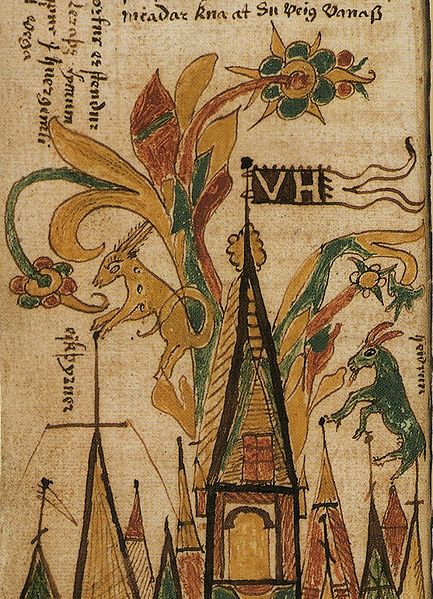 So much
moisture drips from his horns that it falls down
to the well ... "Eikthyrnir the Hart is called, that stands o’er Odin’s
Hall, and bits from Lćrad’s branches; from his horns fall drops into Hvergelmir,
whence all waters rise"
So much
moisture drips from his horns that it falls down
to the well ... "Eikthyrnir the Hart is called, that stands o’er Odin’s
Hall, and bits from Lćrad’s branches; from his horns fall drops into Hvergelmir,
whence all waters rise"
A
10th century Arab Muslim writer named Ahmad ibn Fadlan produced a description
of a funeral of a Scandinavian, probably Swedish, chieftain who was on an expedition
on the eastern route. The account is a unique source on the ceremonies surrounding
the Viking funeral, of a chieftain. The dead chieftain was put in a temporary
grave which was covered for ten days until they had sewn new clothes for him.
One of his thrall women volunteered to join him in the afterlife and she was
guarded day and night, being given a great amount of intoxicating drinks while
she sang happily. When the time had arrived for cremation, they pulled his longship
ashore and put it on a platform of wood, and they made a bed for the dead chieftain
on the ship. Thereafter, an old woman referred to as the "Angel of Death" put
cushions on the bed. She was responsible for the ritual. Then they disinterred
the chieftain and gave him new clothes. In his grave, he received intoxicating
drinks, fruits and a stringed instrument. The chieftain was put into his bed
with all his weapons and grave offerings around him. Then they had two horses
run themselves sweaty, cut them to pieces, and threw the meat into the ship.
Finally, they sacrificed a hen and a cock. Meanwhile, the thrall girl went from
one tent to the other and had sexual intercourse with the men. Every man told
her "tell your master that I did this because of my love to him". While in the
afternoon, they moved the thrall girl to something that looked like a door frame,
where she was lifted on the palms of the men three times. Every time, the girl
told of what she saw. The first time, she saw her father and mother, the second
time, she saw all her relatives, and the third time she saw her master in the
afterworld. There, it was green and beautiful and together with him, she saw
men and young boys. She saw that her master beckoned for her. By using intoxicating
drinks, they thought to put the thrall girl in an ecstatic trance that made
her psychic and through the symbolic action with the door frame, she would then
see into the realm of the dead. The same ritual also appears in the Icelandic
short story Völsa ţáttr where two pagan Norwegian men lift the lady of the household
over a door frame to help her look into the otherworld. Thereafter, the thrall
girl was taken away to the ship. She removed her bracelets and gave them to
the old woman. Thereafter she removed her finger rings and gave them to the
old woman's daughters, who had guarded her. Then they took her aboard the ship,
but they did not allow her to enter the tent where the dead chieftain lay. The
girl received several vessels of intoxicating drinks and she sang and bid her
friends farewell. Then the girl was pulled into the tent and the men started
to beat on the shields so her screams could not be heard. Six men entered into
the tent to have intercourse with the girl, after which they put her onto her
master's bed. Two men grabbed her hands, and two men her wrists. The angel of
death put a rope around her neck and while two men pulled the rope, the old
woman stabbed the girl between her ribs with a knife. Thereafter, the relatives
of the dead chieftain arrived with a burning torch and set the ship aflame.
It is said that the fire facilitates the voyage to the realm of the dead, but
unfortunately, the account does not tell to which realm the deceased was to
go. Afterwards, a round barrow was built over the ashes and in the centre of
the mound they erected a staff of birch wood, where they carved the names of
the dead chieftain and his king. Then they departed in their ships.
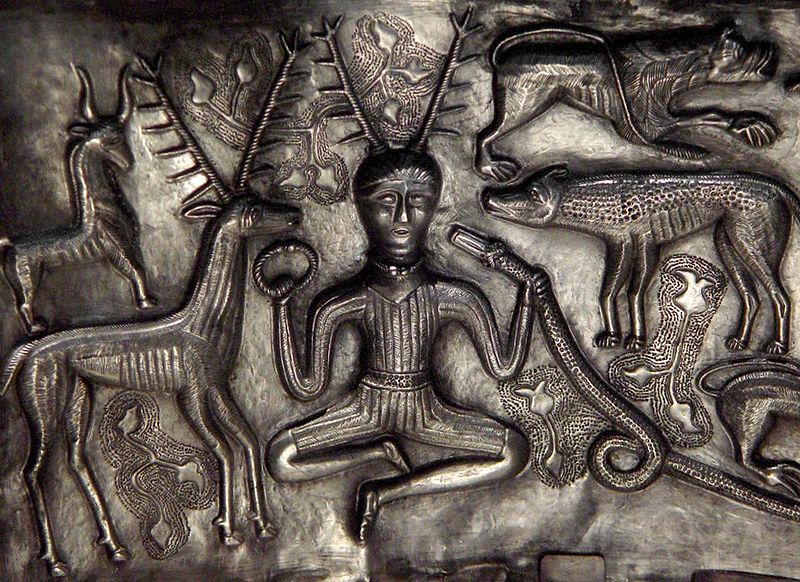 Gundestrup Cauldron
found in Jutland, Denmark; thought to be made in Thracia, it shows a male or
female Stag horned figure in a seated position. In the right hand, the person
is holding a torc; with the left hand, he/she grips a horned serpent by the
head. To the left is a Stag with the identical antlers. The figure could represent
a noble Stag horned male, the "Lord of the Hunt" who occasionally
represents Mercury.
Gundestrup Cauldron
found in Jutland, Denmark; thought to be made in Thracia, it shows a male or
female Stag horned figure in a seated position. In the right hand, the person
is holding a torc; with the left hand, he/she grips a horned serpent by the
head. To the left is a Stag with the identical antlers. The figure could represent
a noble Stag horned male, the "Lord of the Hunt" who occasionally
represents Mercury.
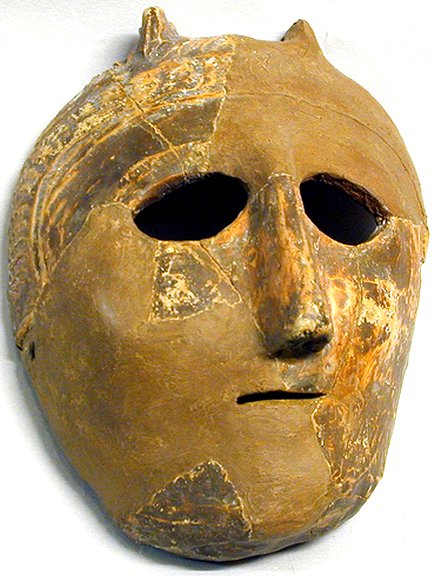 Pottery mask found at a Temple at Catterick Fort, North Yorkshire. The 'horns'
have horizontal holes, possibly to allow pins to secure real Stag antlers in
place [as depicted on the Gundestrup Cauldron] for a God or Goddess of Hunting
or Lord of the Hunt Ceremony.
Pottery mask found at a Temple at Catterick Fort, North Yorkshire. The 'horns'
have horizontal holes, possibly to allow pins to secure real Stag antlers in
place [as depicted on the Gundestrup Cauldron] for a God or Goddess of Hunting
or Lord of the Hunt Ceremony.
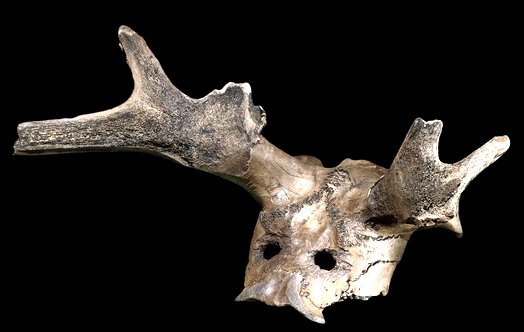 about 9,500 years old From Star Carr, Vale of Pickering, North
Yorkshire. Likely a head-dress; the holes would have been used to tie it to
the head with a leather thong. It could have been worn by hunters as a disguise
but it is more likely that it was part of a costume worn on special occasions,
perhaps during religious ceremonies. [to worship HERTHA, the Earth Goddess ?].
about 9,500 years old From Star Carr, Vale of Pickering, North
Yorkshire. Likely a head-dress; the holes would have been used to tie it to
the head with a leather thong. It could have been worn by hunters as a disguise
but it is more likely that it was part of a costume worn on special occasions,
perhaps during religious ceremonies. [to worship HERTHA, the Earth Goddess ?].
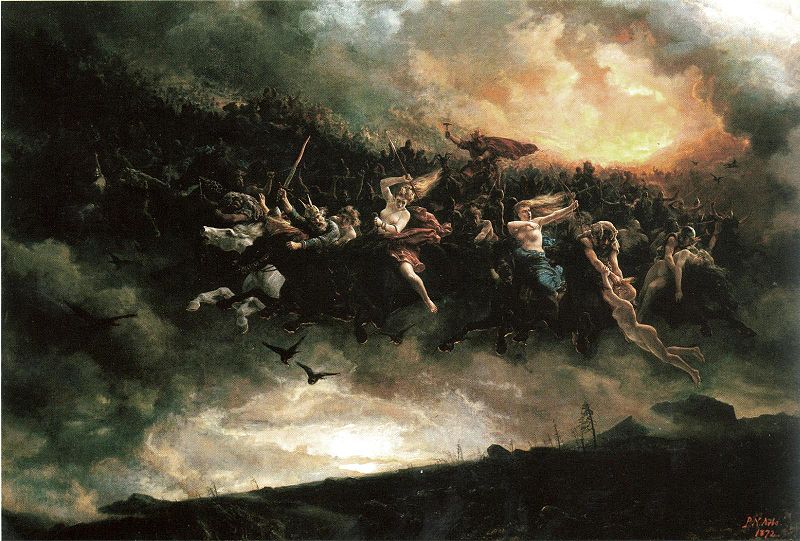 See Wild Hunt led by the
Horned God or Goddess of the Hunt, prevalent across Northern, Western and Central
Europe. The Germanic Harii, those that have died in battle and are brought to
Valhalla by valkyries, painted themselves black to attack their enemies in the
darkness. The Heruli, nomadic, ecstatic wolf-warriors, dedicated themselves
to Wodan. In Danish tradition the hunted is a female troll, old elf named Slattenpat,
which literally means "Wobbly-boob". The ugly-looking Slattenpat runs away putting
her long hanging breasts over her shoulders in order to run faster. Eventually
she is caught up by the wild hunt and killed by the leader.
See Wild Hunt led by the
Horned God or Goddess of the Hunt, prevalent across Northern, Western and Central
Europe. The Germanic Harii, those that have died in battle and are brought to
Valhalla by valkyries, painted themselves black to attack their enemies in the
darkness. The Heruli, nomadic, ecstatic wolf-warriors, dedicated themselves
to Wodan. In Danish tradition the hunted is a female troll, old elf named Slattenpat,
which literally means "Wobbly-boob". The ugly-looking Slattenpat runs away putting
her long hanging breasts over her shoulders in order to run faster. Eventually
she is caught up by the wild hunt and killed by the leader.
 the annual Abbots Bromley, Staffordshire Horn Dance still uses 11thC reindeer
horns. This Germanic foresters' dance certainly took place in Anglo-Saxon and
Viking times and probably dates back to the Nordic Stone Age in Scandinavia
and the Baltic Region.
the annual Abbots Bromley, Staffordshire Horn Dance still uses 11thC reindeer
horns. This Germanic foresters' dance certainly took place in Anglo-Saxon and
Viking times and probably dates back to the Nordic Stone Age in Scandinavia
and the Baltic Region.
and
in Scythian Cuture:
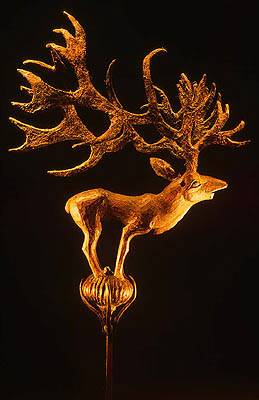 the Scythians had some reverence for the Stag, which is one of the most common
motifs in their artwork, especially at funeral sites. The swift animal was believed
to speed the spirits of the dead on their way, which perhaps explains the curious
antlered headdresses found on horses buried by the Pazyryk,
an Iron Age archaeological culture [c.6thC - 3rdC BC] identified by excavated
artifacts and mummified humans found in the Siberian permafrost in the Altay
Mountains. The mummies are buried in long barrows similar to the tomb mounds
of western Scythian culture in modern Ukraine. The type site are the Pazyryk
burials of the Ukok Plateau. Many artifacts have been found at this location,
including the Ice Princess, indicating a flourishing culture at this location
that benefited from the many trade routes and caravans of merchants passing
through the area.
the Scythians had some reverence for the Stag, which is one of the most common
motifs in their artwork, especially at funeral sites. The swift animal was believed
to speed the spirits of the dead on their way, which perhaps explains the curious
antlered headdresses found on horses buried by the Pazyryk,
an Iron Age archaeological culture [c.6thC - 3rdC BC] identified by excavated
artifacts and mummified humans found in the Siberian permafrost in the Altay
Mountains. The mummies are buried in long barrows similar to the tomb mounds
of western Scythian culture in modern Ukraine. The type site are the Pazyryk
burials of the Ukok Plateau. Many artifacts have been found at this location,
including the Ice Princess, indicating a flourishing culture at this location
that benefited from the many trade routes and caravans of merchants passing
through the area.
So
where did the surname come from [geographically] ? And why the surname HARTLEY
?
Continued
on Page 2:
1]
Who are the Hartleys ? When did they originate ?
2] Where did the surname 'HARTLEY'
come from ? Why the surname, HARTLEY ?
3] Who were some of the earliest HARTLEYs and where
did they come from ?
please
bookmark this website address: hartleyfamily.uk
e-mail
enquiries to: william@hartleyfamily.uk
 Before the Last Great Ice Age: archaeology and DNA analysis have shown
that native Europeans had lived in [what is now] Britain and Ireland for well
over 750,000 years, probably as far back as 1.2 million years ago. Over time,
on several occasions, major shifts in climate had covered the area with ice
sheets over a kilometer thick. These glaciers scraped the land bare and removed
much of what went before. During this time, Homo antecessor, Heidelberg Man,
Neanderthals and Cro-Magnons had populated the land. In relatively recent times,
they had all merged or died out, leaving just one, modern Homo Sapiens, in Europe.
Before the Last Great Ice Age: archaeology and DNA analysis have shown
that native Europeans had lived in [what is now] Britain and Ireland for well
over 750,000 years, probably as far back as 1.2 million years ago. Over time,
on several occasions, major shifts in climate had covered the area with ice
sheets over a kilometer thick. These glaciers scraped the land bare and removed
much of what went before. During this time, Homo antecessor, Heidelberg Man,
Neanderthals and Cro-Magnons had populated the land. In relatively recent times,
they had all merged or died out, leaving just one, modern Homo Sapiens, in Europe.
 between 14 000 years ago and 9 000 years ago: as the Last Great Ice Age
was coming to an end, melting ice raised sea levels. Britain separated from
Ireland, but was still connected to mainland Europe. Growing numbers of native
European nomadic hunter-gatherers [including native Europeans pre-haplogroup
I1] travelled seasonally, by land and by sea, following migrating fish and herds
of animals, including deer. They built substantial 'seasonal camps' in Britain
and Ireland and were the first settlers;
between 14 000 years ago and 9 000 years ago: as the Last Great Ice Age
was coming to an end, melting ice raised sea levels. Britain separated from
Ireland, but was still connected to mainland Europe. Growing numbers of native
European nomadic hunter-gatherers [including native Europeans pre-haplogroup
I1] travelled seasonally, by land and by sea, following migrating fish and herds
of animals, including deer. They built substantial 'seasonal camps' in Britain
and Ireland and were the first settlers;
 aerial map of N.Europe and the N.Atlantic, showing Doggerland surrounding the
British Isles.
aerial map of N.Europe and the N.Atlantic, showing Doggerland surrounding the
British Isles.


 c.7,000BP: the hunter-gatherers were joined by [mostly male] agricultural
settlers from South West Europe and from East Europe and Central Asia including
Samotheans [see later, below]. The vast majority were non-native European male
settlers who brought R1b and R1a male Y-DNA with them and that is the DNA that
is still dominant in Britain and Ireland today; descendents of those early settlers
are also indiginous British and Irish; most present day British and Irish are
descended from them. Some settlers chose native female hunter-gatherers for
mates; together they populated the area. These Europeans and Asians are the
forefathers of the majority of the British and Irish, as well as the Dutch,
Germans and French; hence, most British, Irish, Dutch, Germans and French, today,
are blood-related through common ancestors.
c.7,000BP: the hunter-gatherers were joined by [mostly male] agricultural
settlers from South West Europe and from East Europe and Central Asia including
Samotheans [see later, below]. The vast majority were non-native European male
settlers who brought R1b and R1a male Y-DNA with them and that is the DNA that
is still dominant in Britain and Ireland today; descendents of those early settlers
are also indiginous British and Irish; most present day British and Irish are
descended from them. Some settlers chose native female hunter-gatherers for
mates; together they populated the area. These Europeans and Asians are the
forefathers of the majority of the British and Irish, as well as the Dutch,
Germans and French; hence, most British, Irish, Dutch, Germans and French, today,
are blood-related through common ancestors.  About 6 000 - 7 000 years ago: a large river basin stood between Europe
and the 'British Peninsular', connecting major rivers that ran across Britain
and Europe. About 6000 years ago, as melting ice continued to raise sea levels,
the river basin gradually flooded; sea engulfed the lands once occupied by humans
and wildlife [Doggerland, shown on the map] and formed what is now the North
Sea and English Channel. Henceforth, Britain was cut off by land from continental
Europe and the seasonal migration pattern was broken. Britain became a group
of islands. Some hunter-gatherers and wildlife was stranded in Britain, unable
to get back to the mainland. Other groups would have adapted, travelling to
and fro by boat. Over time, successive waves of new agricultural settlers came
to Britain and Ireland from Europe and Asia, bringing with them different cultures
and technologies, some of which were adopted. Settlers came from near and far,
from the whole of Europe, Turkey and the Middle East, Central Asia, even parts
of North and East Africa. Most of the male DNA brought by new settlers were
of the same haplogroups as that already held by the British and Irish; mostly
R1b, but also R1a and I [M170].
About 6 000 - 7 000 years ago: a large river basin stood between Europe
and the 'British Peninsular', connecting major rivers that ran across Britain
and Europe. About 6000 years ago, as melting ice continued to raise sea levels,
the river basin gradually flooded; sea engulfed the lands once occupied by humans
and wildlife [Doggerland, shown on the map] and formed what is now the North
Sea and English Channel. Henceforth, Britain was cut off by land from continental
Europe and the seasonal migration pattern was broken. Britain became a group
of islands. Some hunter-gatherers and wildlife was stranded in Britain, unable
to get back to the mainland. Other groups would have adapted, travelling to
and fro by boat. Over time, successive waves of new agricultural settlers came
to Britain and Ireland from Europe and Asia, bringing with them different cultures
and technologies, some of which were adopted. Settlers came from near and far,
from the whole of Europe, Turkey and the Middle East, Central Asia, even parts
of North and East Africa. Most of the male DNA brought by new settlers were
of the same haplogroups as that already held by the British and Irish; mostly
R1b, but also R1a and I [M170].

 The Britons: from 4,000 - 3,000 years ago, Britannia [Britain] was being
increasingly populated by 'the Britannic' [Britons]. Britannia is said to be
named after Brutus of Troy, the Trojan-Greek son of Silvius. Silvius was descended
from Ascanius, founder of Alba Longa; his father, Aeneas, hero of Troy, and
was a descendant of Japheth the 'fair skinned one', the son of the Biblical
Noah. The Trojans land on a deserted island and discover an abandoned temple
to Diana [see Hertha, the Earth Mother Goddess, later]. After performing
the appropriate ritual, Brutus falls asleep in front of the goddess's statue
and is given a vision of the land where he is destined to settle, an island
in the western ocean [Britannia] inhabited only by a few giants [powerful].
The Britons: from 4,000 - 3,000 years ago, Britannia [Britain] was being
increasingly populated by 'the Britannic' [Britons]. Britannia is said to be
named after Brutus of Troy, the Trojan-Greek son of Silvius. Silvius was descended
from Ascanius, founder of Alba Longa; his father, Aeneas, hero of Troy, and
was a descendant of Japheth the 'fair skinned one', the son of the Biblical
Noah. The Trojans land on a deserted island and discover an abandoned temple
to Diana [see Hertha, the Earth Mother Goddess, later]. After performing
the appropriate ritual, Brutus falls asleep in front of the goddess's statue
and is given a vision of the land where he is destined to settle, an island
in the western ocean [Britannia] inhabited only by a few giants [powerful]. Goths and Dacians arrived from the West of Scythia, from the Carpathian mountains,
west of the Black Sea, the lower Danube, the Balkans and the island of Sardinia,
some of whom brought male I1[b] Y-DNA [shown in dark blue on the 'Haplogroup
I' map above]
Goths and Dacians arrived from the West of Scythia, from the Carpathian mountains,
west of the Black Sea, the lower Danube, the Balkans and the island of Sardinia,
some of whom brought male I1[b] Y-DNA [shown in dark blue on the 'Haplogroup
I' map above] Atlantic peoples came
in large numbers from present-day France, Spain, Portugal and Italy populated
the South and West of England, Wales and Ireland. They, like the Britons, account
for male R1b Y-DNA commonly found in Britain and Ireland, Germany and France
[shown in dark red on the 'Haplogroup R1b' map above]. Atlantic people included
peoples from Africa and the Middle East, which could account for male E1b1b
Y-DNA found significantly in Ireland. Or some of the E1b1b Y-DNA could have
come from Egyptian males who travelled with Queen Scotta.
Atlantic peoples came
in large numbers from present-day France, Spain, Portugal and Italy populated
the South and West of England, Wales and Ireland. They, like the Britons, account
for male R1b Y-DNA commonly found in Britain and Ireland, Germany and France
[shown in dark red on the 'Haplogroup R1b' map above]. Atlantic people included
peoples from Africa and the Middle East, which could account for male E1b1b
Y-DNA found significantly in Ireland. Or some of the E1b1b Y-DNA could have
come from Egyptian males who travelled with Queen Scotta.
 Homeland of the Northern HARTLEYs today is Lancashire and Yorkshire,
historically part of
Northern Britain controlled by the Brigantes:
Homeland of the Northern HARTLEYs today is Lancashire and Yorkshire,
historically part of
Northern Britain controlled by the Brigantes:
 chariot* In Britain, chariot burials are characteristic of, and almost confined
to, the Iron Age Arras culture associated with the Parisii tribe. [see
below]
chariot* In Britain, chariot burials are characteristic of, and almost confined
to, the Iron Age Arras culture associated with the Parisii tribe. [see
below]
 HERTHA descended from the Throne of Odin and rode there in a chariot,
a carriage covered with a mysterious veil and drawn by two cows. Wherever she
condescends to come and accept the hospitality of humans, there are days of
rejoicing and weddings, no war is fought, no weapon reached for, every iron
object is locked away. Only peace and calm are then known and desired. This
lasts until the Goddess has sojourned long enough among humans and the priest
leads her back again into her sanctuary. Only her consecrated priest was allowed
to accompany her. Slaves were also brought along to lead the draft animals and
to wash the chariot, but they were drowned in the lake immediately upon completing
their task, because any unconsecrated person who caught sight of the Goddess
would have to die. For this reason nothing more is known about the worship of
this Goddess.
HERTHA descended from the Throne of Odin and rode there in a chariot,
a carriage covered with a mysterious veil and drawn by two cows. Wherever she
condescends to come and accept the hospitality of humans, there are days of
rejoicing and weddings, no war is fought, no weapon reached for, every iron
object is locked away. Only peace and calm are then known and desired. This
lasts until the Goddess has sojourned long enough among humans and the priest
leads her back again into her sanctuary. Only her consecrated priest was allowed
to accompany her. Slaves were also brought along to lead the draft animals and
to wash the chariot, but they were drowned in the lake immediately upon completing
their task, because any unconsecrated person who caught sight of the Goddess
would have to die. For this reason nothing more is known about the worship of
this Goddess.
 Many chariots have
been discovered, buried, across Britain and across the world dating from 2000BC
[Bronze Age]. In England, chariot burials are characteristic of, and almost
confined to, the Iron Age Arras culture associated with the Parisii tribe.
Finds of such burials are rare.The Wetwang chariot burial of ca. 300 BC is an
exception in that a woman was interred with the chariot, possibly depicting
the Earth Goddess, Hertha. Twenty one British sites are known, spanning approximately
four centuries, virtually all in the East Riding of Yorkshire. The Ferrybridge
and Newbridge chariots are unusual in Britain as they are the only ones to be
buried intact. The burial custom seems to have disappeared with the Roman occupation
of Britain..
Many chariots have
been discovered, buried, across Britain and across the world dating from 2000BC
[Bronze Age]. In England, chariot burials are characteristic of, and almost
confined to, the Iron Age Arras culture associated with the Parisii tribe.
Finds of such burials are rare.The Wetwang chariot burial of ca. 300 BC is an
exception in that a woman was interred with the chariot, possibly depicting
the Earth Goddess, Hertha. Twenty one British sites are known, spanning approximately
four centuries, virtually all in the East Riding of Yorkshire. The Ferrybridge
and Newbridge chariots are unusual in Britain as they are the only ones to be
buried intact. The burial custom seems to have disappeared with the Roman occupation
of Britain..
 The name Brigantes was linked to the Goddess Brigantia who was the Roman
Goddess Minerva, the daughter of Jupiter, the virgin goddess of warriors, poetry,
medicine, wisdom, commerce, weaving, crafts, and the inventor of music. She
is often depicted with an owl, her sacred creature and, through this connection,
a symbol of wisdom; she was also the Greek Goddess Athena, the daughter of Zeus,
the virgin goddess of wisdom, peace, warfare, strategy, handicrafts and reason,
shrewd companion of heroes and the goddess of heroic endeavour. Brigantia appears
attended by an owl, the sign of Wisdom; as the Goddess of Wisdom, Brigantia
may have links to the Greek Milesians as they were Philosophers, Writers, Architects
and Scientists.
The name Brigantes was linked to the Goddess Brigantia who was the Roman
Goddess Minerva, the daughter of Jupiter, the virgin goddess of warriors, poetry,
medicine, wisdom, commerce, weaving, crafts, and the inventor of music. She
is often depicted with an owl, her sacred creature and, through this connection,
a symbol of wisdom; she was also the Greek Goddess Athena, the daughter of Zeus,
the virgin goddess of wisdom, peace, warfare, strategy, handicrafts and reason,
shrewd companion of heroes and the goddess of heroic endeavour. Brigantia appears
attended by an owl, the sign of Wisdom; as the Goddess of Wisdom, Brigantia
may have links to the Greek Milesians as they were Philosophers, Writers, Architects
and Scientists.
 During early Roman times, the ruling Queen of the Brigantes was Cartimandua
[c.43-70AD] [the style of dress depicted in the picture is taken
from the film 'King Arthur [2004]'], who was married to her consort,
Venutius* [who was an anti-Roman warlord, see above]. Cartimandua was a 'living
deity', the Goddess Brigantia, the High Goddess.
During early Roman times, the ruling Queen of the Brigantes was Cartimandua
[c.43-70AD] [the style of dress depicted in the picture is taken
from the film 'King Arthur [2004]'], who was married to her consort,
Venutius* [who was an anti-Roman warlord, see above]. Cartimandua was a 'living
deity', the Goddess Brigantia, the High Goddess.  It is said the Anglo-Saxons came from Germania; they comprised: Jutes, Angles,
Frisians, Rugians [Rugii], Saxons, Huns and Boructuari [see next map below].
Having depended on professional Roman soldiers for centuries, the Britons were
unable to deal with raids carried out by the Picts and Scots. It is said the
King of the Britons, Wurtgern, called for help from the Germans and Danes, a
big mistake on the part of the Britons. Help came from North West Germany and
Denmark, areas still known today as Jutland, Friesland and Saxony; the Angles
came from 'the angle between the two', also known as Angeln, an area between
Schleswig, Kappeln and Flensburg.
It is said the Anglo-Saxons came from Germania; they comprised: Jutes, Angles,
Frisians, Rugians [Rugii], Saxons, Huns and Boructuari [see next map below].
Having depended on professional Roman soldiers for centuries, the Britons were
unable to deal with raids carried out by the Picts and Scots. It is said the
King of the Britons, Wurtgern, called for help from the Germans and Danes, a
big mistake on the part of the Britons. Help came from North West Germany and
Denmark, areas still known today as Jutland, Friesland and Saxony; the Angles
came from 'the angle between the two', also known as Angeln, an area between
Schleswig, Kappeln and Flensburg. 
 5thC European Tribes
5thC European Tribes
 a Royal Scepter found at the Sutton Hoo burial site in England features a depiction
of an upright, antlered Stag.
a Royal Scepter found at the Sutton Hoo burial site in England features a depiction
of an upright, antlered Stag.  So much
moisture drips from his horns that it falls down
to the well ... "Eikthyrnir the Hart is called, that stands o’er Odin’s
Hall, and bits from Lćrad’s branches; from his horns fall drops into Hvergelmir,
whence all waters rise"
So much
moisture drips from his horns that it falls down
to the well ... "Eikthyrnir the Hart is called, that stands o’er Odin’s
Hall, and bits from Lćrad’s branches; from his horns fall drops into Hvergelmir,
whence all waters rise"
 Pottery mask found at a Temple at Catterick Fort, North Yorkshire. The 'horns'
have horizontal holes, possibly to allow pins to secure real Stag antlers in
place [as depicted on the Gundestrup Cauldron] for a God or Goddess of Hunting
or Lord of the Hunt Ceremony.
Pottery mask found at a Temple at Catterick Fort, North Yorkshire. The 'horns'
have horizontal holes, possibly to allow pins to secure real Stag antlers in
place [as depicted on the Gundestrup Cauldron] for a God or Goddess of Hunting
or Lord of the Hunt Ceremony.
 about 9,500 years old From Star Carr, Vale of Pickering, North
Yorkshire. Likely a head-dress; the holes would have been used to tie it to
the head with a leather thong. It could have been worn by hunters as a disguise
but it is more likely that it was part of a costume worn on special occasions,
perhaps during religious ceremonies. [to worship HERTHA, the Earth Goddess ?].
about 9,500 years old From Star Carr, Vale of Pickering, North
Yorkshire. Likely a head-dress; the holes would have been used to tie it to
the head with a leather thong. It could have been worn by hunters as a disguise
but it is more likely that it was part of a costume worn on special occasions,
perhaps during religious ceremonies. [to worship HERTHA, the Earth Goddess ?].
 See
See  the annual Abbots Bromley, Staffordshire Horn Dance still uses 11thC reindeer
horns. This Germanic foresters' dance certainly took place in Anglo-Saxon and
Viking times and probably dates back to the Nordic Stone Age in Scandinavia
and the Baltic Region.
the annual Abbots Bromley, Staffordshire Horn Dance still uses 11thC reindeer
horns. This Germanic foresters' dance certainly took place in Anglo-Saxon and
Viking times and probably dates back to the Nordic Stone Age in Scandinavia
and the Baltic Region.
 the Scythians had some reverence for the Stag, which is one of the most common
motifs in their artwork, especially at funeral sites. The swift animal was believed
to speed the spirits of the dead on their way, which perhaps explains the curious
antlered headdresses found on horses buried by the
the Scythians had some reverence for the Stag, which is one of the most common
motifs in their artwork, especially at funeral sites. The swift animal was believed
to speed the spirits of the dead on their way, which perhaps explains the curious
antlered headdresses found on horses buried by the